- Skip to main content
- Skip to secondary menu
- Skip to primary sidebar
- Skip to footer
Istanbul Clues
Istanbul Tour Guide

Istanbul Tourist Attractions Map PDF (Updated → 2024)
5 May 2024 by Serhat Engül
There are many tourist attractions in Istanbul. Visitors to the city first focus on buildings such as Hagia Sophia , Blue Mosque and Topkapi Palace. These are easy to find as they are within walking distance of each other. However, in order to find other historical sites, it is necessary to examine the Istanbul tourist attractions map . Because there are many more places to explore in Istanbul.
While doing research on the internet, I realized that there were not enough visual resources about Istanbul. Of course, it is possible to find various maps, but I have not come across a resource where foreign tourists can find all they need to know.
As a tour guide in Istanbul for 15 years, I know what those who want to visit Istanbul need to know. For this reason, I tried to prepare a comprehensive article that will meet all the needs of those planning a vacation in Istanbul.
Table of Contents
Istanbul Tourist Attractions Map PDF 2024
Istanbul Tourist Attractions Map (2024) post has ten titles. We will explore Istanbul together on the maps I have shared under these headings. We will start from the most popular tourist destinations such as Sultanahmet and Beyoglu, and slowly expand the circle.
First of all, I should point out that these maps do not belong to me. I used maps published by various sources as drafts and processed them. In the article, you will see a selection of maps published by Beyoglu Municipality, Istanbul Metropolitan Municipality, Google Maps and Turkish Airlines.
I processed these maps with Microsoft Paint. The maps may seem primitive as I am not a professional in this field. However, they provide visual support for what I want to tell. Likewise, it will enable readers to gain basic knowledge.
I made PDF files of the Istanbul tourist attraction maps that have enough details to be examined closely. You can find links to PDF versions of each Istanbul tourist map under the relevant headings. You can download these maps for free. Yes, now let’s start our article with the hope that it will be useful.
1. Fatih (Historic Peninsula) and Beyoglu
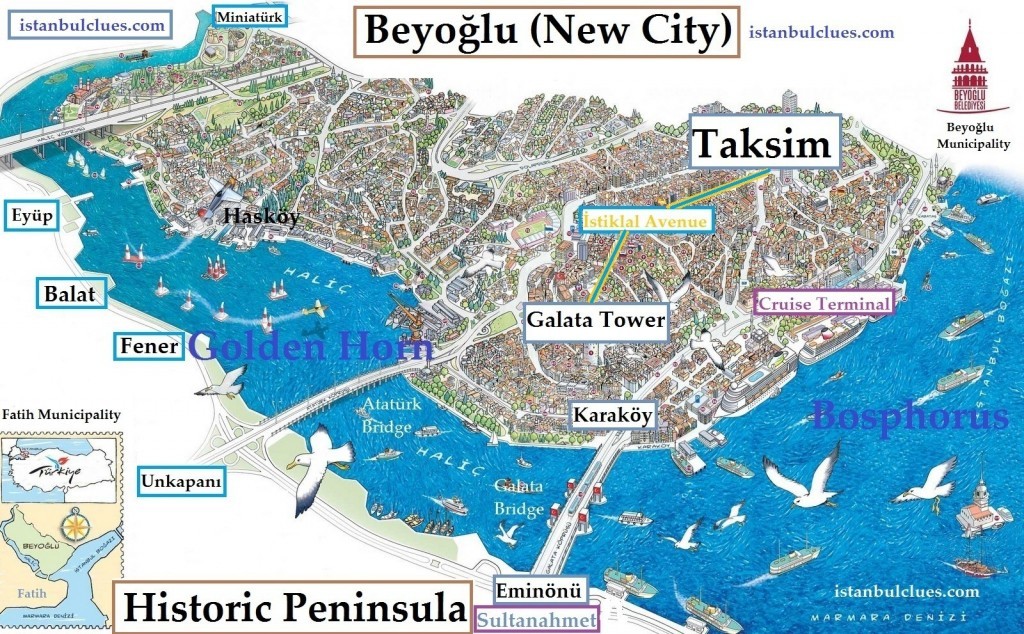
Most of the historical places in Istanbul are located in Fatih (Old City) and Beyoglu (New City). For this reason, it is necessary to know well where these two districts are located.
Fatih district is better known as the Old City or Historical Peninsula and has a history dating back to 2700 BC. The hill where Topkapi Palace is located in the east of the Historic Peninsula is the place where Istanbul was first founded in ancient times.
There are countless historical monuments to visit in the Historic Peninsula. The most famous of these works stand out as Hagia Sophia, Blue Mosque , Topkapı Palace and Grand Bazaar . These historical artifacts, which host millions of visitors a year, form the showcase of Istanbul.
Beyoglu district is also a very old settlement. However, the number of historical monuments is less compared to Fatih district. Beyoglu stands out with mostly walking streets, shopping places and activities.
Tourists who come to Istanbul and stay for 2 or 3 days usually visit these two districts. It only takes a few days to visit the famous mosques and museums in the Historic Peninsula and explore Istiklal Street (Beyoglu) and its surroundings.
Apart from visiting the Historic Peninsula and Beyoglu, the most common activity is taking a boat tour on the Bosphorus. Those who have time go to the Asian Side and visit the Kadıkoy Fish Market. According to millions of tourists, Istanbul consists only of these districts.
The Fatih and Beyoglu map above shows us the location of the two districts and the Golden Horn that separates them. Galata Bridge joins the two districts separated by the Golden Horn, which is a natural waterway.
There is Eminonu on one side of the Galata Bridge and Karakoy on the other. These two districts are places that represent the historical development and cosmopolitan food culture of Istanbul.
2. Map of Istanbul Old City (Sultanahmet)
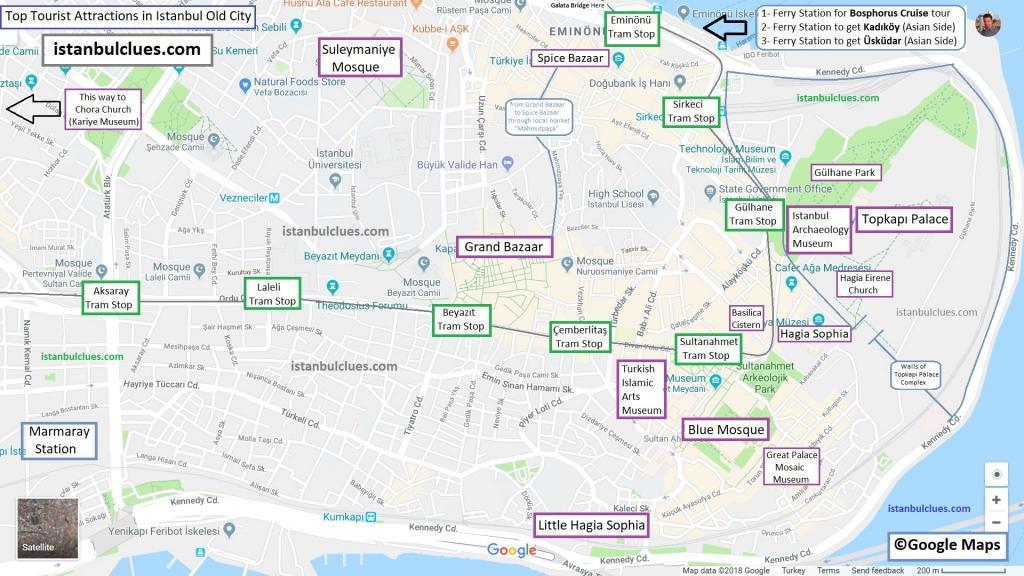
The best way to travel between Istanbul Old City and Beyoglu districts is to use the tram. You can reach historical monuments in Sultanahmet from many parts of Istanbul thanks to the tram. On the other hand, you can use the tram to get to Dolmabahce Palace , which is the most important work to see after the places in Sultanahmet.
You can see the tram stops marked in green on the tourist map of Istanbul Old City . Historical monuments to see in Sultanahmet and its surroundings are lined up on the road between Beyazit and Eminonu tram stops.
After Eminonu , which is the last stop in the Old City, the tram crosses the Galata Bridge and reaches Beyoglu district. On the next map, you will see that the tram reaches Karakoy after passing the Galata Bridge.
You can view the Sultanahmet Map on the new tab via this link .
3. Map of Beyoglu (Taksim) District
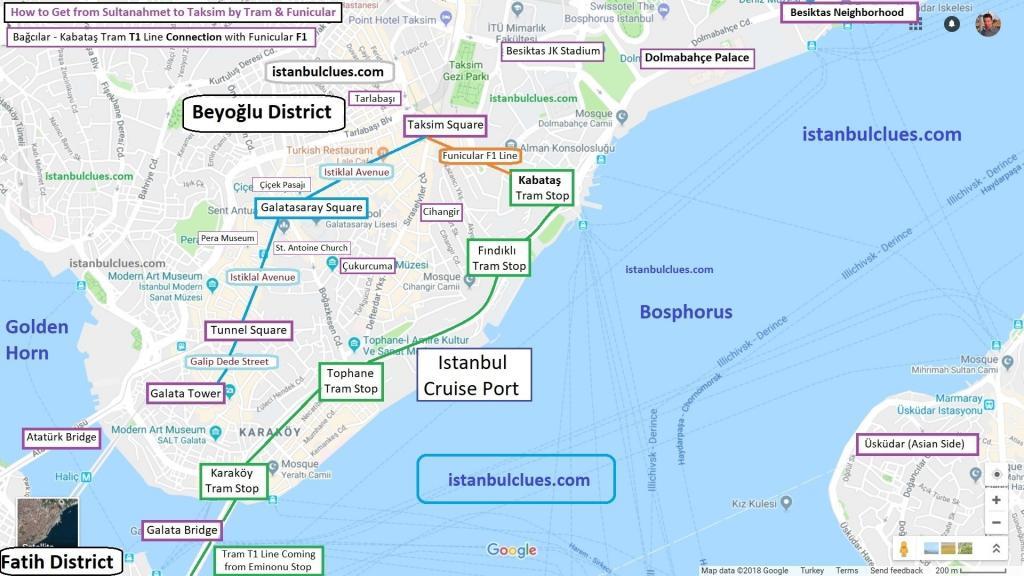
Karakoy is one of the fastest growing districts of Istanbul in recent years. Karakoy, where many boutique hotels, cafes and restaurants have opened in recent years, has become a tourist attraction. Karakoy neighborhood became even more popular with the opening of Galataport .
After Karakoy, the tram stops at Tophane district where Kilic Ali Pasha Mosque is located. Findikli , the next stop, is where the Istanbul Modern museum is. Kabatas , the last stop, is the most important stop of the tram in Beyoglu.
You can see that Kabatas is a transfer point on the tourist map of Beyoglu District . When you get off the tram at the last stop, Kabatas, you can easily go to Taksim Square by the F1 funicular connection. Or you can walk to Dolmabahce Palace in just 5 minutes.
Taksim Square is also where Istanbul’s most popular walking street, Istiklal Avenue , begins. While walking on Istiklal Avenue, you will pass through two squares called Galatasaray Square and Tunnel Square. You can also reach Galata Tower by following the same route.
You can view the Beyoglu (aka Taksim) map on the new tab from here .
4. Golden Horn Bridges
We mentioned that Beyoglu and Fatih districts are separated from each other by the Golden Horn. There are 3 main bridges connecting the two districts. One of them is the Historical Galata Bridge . The bridge, over which the tram passes, is used extensively by tourists.
On the other hand, you can reach Ataturk Bridge from Taksim Square through Tarlabasi Boulevard, which extends to the Historical Peninsula. Thanks to this bridge, you can connect to Unkapani and reach Ataturk Boulevard, the heart of Fatih district.
There are historical monuments such as Valens Aqueduct and Sehzade Mosque on Ataturk Boulevard. There are also Zeyrek Mosque (aka Church of Christ Pantokrator ) and Suleymaniye Mosque in its close vicinity.
The third bridge on the map, the Metro Bridge , belongs to the M2 Metro line from Haciosman and going to Yenikapi. Thanks to this bridge, those coming from Beyoglu can reach Marmaray.
On the other hand, those who set off from Istanbul Old City can reach places such as Taksim Square, Sisli and Levent by M2 Metro. The best shopping malls of Istanbul are located in these districts.
You can view the Golden Horn Bridges on the new tab via this link .
5. Istanbul Public Transport Map
Istanbul metro has made great progress in recent years. With the integration of Marmaray into the system, travel in the European and Asian sides of Istanbul has become much easier.
In this way, someone who gets on Marmaray from Istanbul Old City can go to Kadikoy in just 8 minutes, and from there you can reach the interior of the Asian Side by transferring to the M4 metro.
One of the biggest problems of tourists who used to stay in the Old City was that it was difficult to reach shopping places of Istanbul . However, now it is very easy to go from Yenikapı to Sisli and Levent via M2 metro. These are the districts of Istanbul with modern shopping venues.
In addition, with the Marmaray and M4 connection, getting to the shopping centers on the Asian Side and Sabiha Gokcen Airport has become very easy.
If you want to learn more about the metro, Marmaray and tram in Istanbul, you can also take a look at the Istanbul Metro Map article. In that article, I explained the Istanbul Public Transport Map in detail.
You can find the PDF version of the map above from this link .
6. Istanbul Ferry Map
Istanbul Ferry Map shows us the locations of the major ferry ports. Istanbul’s nostalgic ferries allow us to travel between the European and Asian sides as well as to take a Bosphorus cruise in Istanbul.
For example, piers 1, 2 and 5 on the map show tour boats making a Bosphorus tour. Pier 1 belongs to the Turyol Bosphrous boats. Pier number 2 belongs to Sehir Hatlari ‘s Bosphorus Cruise Ferries. Pier 5 belongs to Dentur Bosphorus boats departing from Kabatas. You can find more explanatory information for the Bosphorus cruise in this article .
Pier 3 symbolizes the ferries departing from Eminonu (Old City) to Uskudar and Kadikoy on the Asian side. There are actually two separate piers here, but I thought a single figure would be enough for both.
Pier 6 symbolizes the ferries departing from Besiktas to Kadikoy and Uskudar. Piers 7 and 8 are located in Uskudar and Kadikoy , two touristic districts of the Asian Side. Ferries depart from both to Besiktas and Eminonu.
You can view the above Istanbul ferry map as PDF via this link .
7. Istanbul Accommodation Map
It is difficult to decide where to stay in Istanbul. Because there are thousands of hotels in Istanbul and it is difficult to decide which area is best to stay. Accommodation places such as Sultanahmet, Beyoglu and Besiktas have both pros and cons.
Istanbul Accommodation Map shows us the locations of the best hotels in Istanbul . If you want to dig deeper about this subject, you can find all the details in the article on the best places to stay in Istanbul .
Istanbul accommodation map also serves us as a map of Istanbul tourist attractions. Because the most important historical monuments of Istanbul are located in these marked districts.
You can view the map above in high resolution here .
8. Map of Istanbul Districts
The maps I have shared so far included mostly tourist attractions. Map of Istanbul Districts allows us to view the city from a wider perspective. Thanks to this map, you can see the other districts where Istanbul residents live from a bird’s eye view.
There is only one thing that needs to be updated on this map. That is, Ataturk Airport is not used anymore. The location of the new Istanbul Airport is not visible on the map. However, we can say that it is close to Kemerburgaz, which can be seen in the far north.
On the other hand, Sabiha Gokcen Airport, located inside the Asian Side, can be clearly seen on this map. There are even Prince Islands that we cannot see on other maps.
You can view a better version of the Istanbul Districts Map from here .
9. Istanbul Sightseeing Map
The touristic places of Istanbul are mainly gathered in five districts. These are Fatih, Beyoglu, Besiktas, Uskudar and Kadikoy districts. This high resolution map prepared by the Istanbul Metropolitan Municipality introduces all the must-see places in these five districts with illustrations.
As a traveler, I have always liked maps with illustrations. Because the location of historical artifacts becomes clearer in illustration maps. Historic places depicted like artwork on the map become more attractive.
Istanbul Sightseeing Map creates the same effect by highlighting all the iconic buildings of the city. Ferries, Maiden’s Tower, stadiums and historical artifacts are beautifully highlighted. Even the seagulls, one of the symbols of Istanbul, have not been forgotten.
You can find the PDF version of Istanbul Sightseeing Map from here .
10. Istanbul Tourist Attractions Map
Istanbul Tourist Attractions Map also includes illustrations. This map published by Turkish Airlines shows us historical places to visit in Istanbul.
Those who visit the places marked on this map will have an excellent Istanbul experience. Because the map contains all the places that should be visited in Istanbul for the first time.
Of course, those who stay in Istanbul for a long time or those who come for the second time can visit more specific places. As Istanbul has hosted many civilizations, it has a history consisting of many layers.
Istanbul has been the capital of the Roman, Byzantine and Ottoman empires in history. You can concentrate on each of these periods separately. For example, the Byzantine history tour in Istanbul is a good example of this.
Most of the popular museums in Istanbul can be entered with a museum card. The museums marked on the map above actually show museums that can be visited with the museum card. You can also check the Istanbul Museum Pass article for more information on this subject.
You can find the PDF of Istanbul Tourist Attractions Map from this link .
Istanbul Tourist Maps on Youtube
I recently published a video on Istanbul Tourist Attraction Maps on YouTube . Since I am not a videographer, I cannot say that it is technically a perfect video. But I am sure that you will get useful information if you watch it to the end. If you will find this content useful, you may like the video and subscribe to my channel. And finally, I wish you a good trip. You can find the related video by clicking the link here .
About Serhat Engül
Hello explorer of Istanbul! This is Serhat Engul. I am a licensed TOUR GUIDE IN ISTANBUL. I offer PRIVATE HALF DAY TOUR which includes a visit to the Hagia Sophia, Blue Mosque, Hippodrome, Basilica Cistern and the Spice Bazaar. This is a fantastic option to see some of the ICONIC LANDMARKS in the whole of Istanbul and you’ll receive plenty of background information on each location to enlighten you. You may see the details of this tour on the HOMEPAGE of the blog. I wish you a wonderful trip!
Reader Interactions
9 September 2018 at 19:25
Great maps and information, I will be in Istanbul in two weeks for vacation, definitely I will use this website
9 September 2018 at 22:23
Hello Nora, thank you for expressing your appreciation. Good motivation for us to carry on improving the blog. Have a good holiday in Istanbul!
1 March 2024 at 00:51
Serhat, you have done an exceptional job in providing this information.
1 March 2024 at 18:34
Hi Sanjay, thank you for the feedback. Have a nice trip!
26 April 2019 at 05:29
Serhat, This is an absolutely terrific resource. The best and most complete (and useful) info I have found for visiting Istanbul. Will arrive there next week and can’t wait to see it all, thanks to your help. Thanks for creating this great blog. Doug in DC
26 April 2019 at 09:57
Hi Doug, thank you very much for this great feedback. It’s encouraging to see such reviews. I wish you a great holiday here. Kind regards, Serhat.
7 May 2019 at 13:37
Hi Serhat! Thank you for the detailed maps. I’ll be in Istanbul for about 2 and a half days in the third week of May. I’m staying at Hotel Anthemis,Fatih. Could you please suggest a suitable itinerary for 9 pax. Also we are vegetarians so could you recommend good restaurants as well?
7 May 2019 at 17:22
Hi Rachita! My favorite itinerary is: 1st day: Hagia Sophia, Blue Mosque, Topkapı Palace, Hippodrome, Basilica Cistern, Spice Bazaar >>> 2nd day: Short Bosphorus Cruise Tour, Suleymaniye Mosque, Grand Bazaar, Dolmabahce Palace, Galata Tower (and walking on Istiklal Avenue from the tower) >>> 3rd day (As a half-day activity) Take a ferry to Kadikoy (Asian Side) visit the fish market, make shopping on Bahariye Avenue, eat at Chiya (Çiya) Restaurant. >>> For the best restaurants of Istanbul, you are advised to check Food & Drink Category . There are a lot of detailed posts about it.
30 May 2019 at 14:53
This article is very helpful. Thank you!
30 May 2019 at 17:14
Dear Hoxha, thank you for the great review! I am glad that it’s been helpful to you.
28 September 2019 at 13:50
I cant thank you enough. This website is awsome. 🙂
28 September 2019 at 21:19
Dear Kazi Uddin, thank you for the feedback. It’s great to see that the website has been useful to you!
16 August 2021 at 13:21
Dear Serhat, thanks a lot about your complete and useful website, it helps many tourists through their trips ??
16 August 2021 at 18:07
Dear Asghar, thank you so much for your nice words. It feels really cool to see the blog work for travelers.
30 October 2019 at 14:41
Dear Serhat,
Thank you so much for this detailed information.
I have been in Istanbul many times about seven or eight times or more.
I’ll definitely use this website whenever i visit Istanbul. I’ve realized there are so many places i didn’t cover.
I’m working with Turkish Airlines here in Tanzania, i never get tired visiting your beautiful city.
Best regards, Suleiman.
30 October 2019 at 21:41
Dear Suleiman, thank you for the feedback. I am glad that website inspired you for seeing more in Istanbul. Best, Serhat.
7 December 2019 at 00:48
Very complex your blog. We are visiting Istanbul during New’s Year Eve 2020. We will stay 8 nights. Could you please help us with some advices regarding the best location and also some ideas for the itinerary? Where can we see the fireworks?
Thank you, Bogdan
7 December 2019 at 12:48
Hi Bogdan, thank you for your nice words about my blog. I think you have made two comments under different posts. The first question is the same. So I answered your question regarding the New Year Celebrations in Istanbul on Festivals and Events page.
About your itinerary, I recommend you two blog posts: Things to do in Istanbul and Places to visit in Istanbul . About the best area to stay, you may want to read this one: where to stay in Istanbul .
I hope these links would be useful. Cheers!
1 February 2020 at 20:37
Visiting Istanbul from India in March 2020. Found your website so useful. Will be referring to it the WHOLE TIME!
1 February 2020 at 21:15
Hi Seher, thank you for the feedback. I wish you to have a great holiday in Istanbul!
14 April 2020 at 18:17
Dear Serhat
Thank you for providing detailed map of Istanbul. I`ll be in Istanbul in 18-21 Aug, 2020. I shall definitely use you website during the the journey of Istanbul. Thank Nazir
14 April 2020 at 19:51
Dear Nazir,
Thank you very much for your kind words about my website. I wish that you would have great time here in Istanbul.
10 January 2021 at 10:03
Wow, what an amazing info, i will be there soon after the lock down. Thank you brother for this detailed information.
10 January 2021 at 11:45
Salam Mohamed, thank you for the feedback. I hope you will have a great time in Istanbul.
20 December 2021 at 18:54
Wonderful maps. Some day I’ll return to Istanbul – I spent a year living in Moda/Kadikoy and have a deep desire to return. I’ll definitely be contacting you if I’m ever so lucky again. Thanks much!
20 December 2021 at 19:28
Hi Robert, thank you very much for your feedback on the maps. Indeed, Kadikoy and especially Moda district is a great place to live. The new generation cafes and restaurants in Moda are the best in their field.
In recent years, Istanbul’s nightlife sector and Cihangir’s intellectual settlers have also moved there. In this way, Moda is the coolest district in Istanbul in recent years. I hope you will come back to Istanbul sometime in the future.
21 January 2022 at 18:07
Serhat, the information you give is precious and exceptional! and it is so clear and in order.. Right now, it is impossible to know when one will be able to travel, but when the time comes, I will have your info printed, and will contact you for a guided tour. You are a generous professional. The best of luck for you, and I hope we will meet in not too long.
21 January 2022 at 18:37
Dear Dinorah Sanz, thank you for your generous comment. Seeing such detailed reviews is definitely worth the effort I put into writing these blogs. It’s nice to be able to help people from different parts of the world. Hope to see you one day in the future!
26 March 2022 at 14:35
Great article and very helpfull. Please do you know are shops, malls and caffes working on 1st and 2nd of May 2022. Thank you!
26 March 2022 at 20:50
Hello Ana, on May 1, cafes, malls and shops will be open. However, some of the main roads in the city may be closed due to the May Day celebrations. Especially getting to Taksim Square can be difficult.
27 March 2022 at 11:48
Many thanks for sharing your knowledge and insights. The maps, guide to public transport and narratives were very helpful. These made my Istanbul trip so much easier.
I have to come back to absorb Istanbul more and would hopefully be able to get you to guide. Stay blessed and keep making the World a better place.
27 March 2022 at 19:55
Hi Symran, thank you very much for your feedback. Yes, Istanbul is too big to explore in one visit. You can contact me next time you want to go into more details.
18 April 2022 at 10:43
Hello, could you post more information about the car parks in Istanbul. We will travel by car and we want the car to be in the parking lot for the days we are there / 3 nights /. Our hotel is in Fatih on Pierre Loti Street. Great City Guide ! Thank you!
19 April 2022 at 12:08
Parking lots operated by the Metropolitan Municipality in Istanbul are called ISPARK. As far as I know, there is a large-capacity parking garage in Eminonu.
Access to Sultanahmet (Old City) by car is very limited. There are several open parking spaces in the streets surrounding the Hagia Sophia and the Blue Mosque.
Some of these parks are operated privately, while others are provided by ISPARK for daily parks. There is an ISPARK very close to the Blue Mosque. Next to the Sultanahmet Palace hotel.
19 April 2022 at 09:09
Wow!! Very helpful info.. Already download your maps to my phone. and will bring it with me to Istanbul next month..
Thank you very much Serhat…
19 April 2022 at 12:09
Hi Nate, thank you for this great feedback!
23 May 2022 at 13:56
Really useful maps and advice – thanks so much! Going for 5 nights at the end of June . Do you have any recommendations for a (cheap) Bosphorus sunset tour with no alcohol or music on board but with good, informative tour? Also, any suggestion of nice places to eat in the SultanAhmet area? Look forward to hearing from you!
23 May 2022 at 19:40
Hi Shannon, thanks for the feedback. In fact, the answers to your questions are already in the blog posts. You can find my advice about Bosphorus tours in this article . I also listed the best restaurants in Sultanahmet in this one .
26 May 2022 at 23:54
Thanks for the links! This is one of the best Istanbul blogs I have come across mashaAllah!
27 May 2022 at 23:37
You are welcome Shannon. Have a nice trip!
5 June 2022 at 02:51
Thanks for the great information. We are a party of four and would be interested in a half day tour. We are arriving on Friday night 6/9/22. Could you please give us more information and pricing. Thanks, Greg.
6 June 2022 at 11:15
Hi Greg, thank you for the feedback. I will contact you from the email address registered in the system.
8 July 2022 at 10:18
Is there a possibility to go from Istanbul to the Black Sea?
8 July 2022 at 21:41
Hi Miguel, yes it is possible to go to the Black Sea coast of Istanbul. Actually, you can do this in two ways.
First, you can take the Bosphorus Cruise ferry that departs from Eminonu (6-hour full-day excursion) and go to Anadolu Kavagi. The closest village to the Black Sea coast of the Bosphorus is in this area.
Secondly, you can go to Kilyos (European Side) or Şile (Asian Side), which have beaches on the Black Sea coast of Istanbul.
6 August 2022 at 11:04
Thanks for the useful blog. Its great! We will be visiting Istanbul this month with 4 children. Please advise if its worth buying day metro or bus pass and also museum passes.
Which museums are free and which one need buying passes? I prefer walking to tourist sites. Please advise best places for breakfast and dinner.
6 August 2022 at 19:51
This website was created to answer these questions. If you open the categories above and take a look at the articles, you will find answers to your questions.
Considering your questions, I suggest you review the “Clues”, “Getting Around” and “Food & Drink” categories. Have a nice holiday!
10 September 2022 at 14:02
Hello to Istanbul Clues team,
Very well done and professional. Thanks for the information you shared. I will be relying on your tips during my visit to Istanbul.
10 September 2022 at 15:11
Dear Amirhossein, Thanks for your nice words about my blog. Feedback like this encourages me to do more. Have a nice holiday!
14 October 2022 at 21:34
I am so pleased to have found your site, it is very helpful. Thanks for your effort.
15 October 2022 at 11:20
Hi Norman, thank you for the feedback. Have a nice trip.
24 May 2023 at 10:10
What a beautiful write up. Istanbul is printed in my mind now. I know where to go and what to see.. Thanks for sharing this, kudos.
Hands down, best ever compilation of information.
24 May 2023 at 12:35
Hi Richa, I am glad to see that this piece of information worked for you. Thank you for the feedback and have a nice trip in Istanbul!
11 June 2023 at 15:47
Hi Serhat Engül,
I have been reading your articles on the internet, you have some very good information.
I want to buy the Istanbul Museum card, I will be in Istanbul on June 22nd, 2023. Can I buy the card online or best to buy in Istanbul? Is it a physical plastic card or a pdf to print at home? Which site would be the best to buy the card in Istanbul, the shortest queues?
Thank you, Stephen
12 June 2023 at 17:56
Hi Stephen, thanks for your kind feedback on the blog. I recommend you to buy the museum pass from Istanbul. The Museum Pass is a plastic card that takes only 5 minutes to purchase at the ticket offices of museums. You can find the rest of the details in this article .
15 August 2023 at 17:36
Hi Serhat… It is great finally I can find this useful information. I am going to visit Istanbul, Bursa and Mount Uludag in the end of this year 2023 from 29 December to 02 Janunary. How is the weather would be… I hope it will not be too cold…
16 August 2023 at 17:50
Hello Lusia, the date range you mentioned is the coldest time in Istanbul. Normally we expect the weather to be between 4 and 12 degrees on those dates.
However, due to global warming in recent years, the air temperature is unpredictable. For example, December of 2022 was above 15 degrees, almost like April of a spring.
8 May 2024 at 22:28
Merhaba Serhat!
You and your articles are awesome!
Next year my friend and I will travel independently to Turkey for 45 days and plan to stay in Istanbul for 10 nights ( 5 nights on the European side and 5 nights on the Asian side.)
Please let me know if you have any tips for elderly travelers. We are both healthy and mobile 79-year old widows with a good experience traveling independently (to Switzerland, France, Italy, Germany) using their public transportation for extended periods of time.
We are working on our itinerary and are so excited! This will be our first visit to Turkey but we love Turkish movies and films and have managed to pick up quite a few Turkish words and phrases here and there.
We look forward to visiting your beautiful country!
Çok teşekkür ederim, Maria (from California USA)
14 May 2024 at 10:31
Hello Maria,
First of all, thank you for your kind comment about my website.
Please excuse me for taking so long to respond. The comments were deleted due to a hosting problem and I was only able to restore them.
Frankly, I believe that you will enjoy visiting districts such as Sultanahmet (including Eminonu), Beyoglu (Karakoy, Galata Taksim), the Bosphorus shores (Ortakoy, Bebek, Rumeli Hisarı) and Kadikoy on the Asian Side.
Turkish TV series are also shot in these districts. I think you will remember many streets and houses from the scenes in the TV series.
Have a nice holiday.
Rica ederim, Serhat Engul
19 May 2024 at 21:47
Merhaba Serhat!
No problem, I deeply appreciate your response. Çok teşekkür ederim!
We’ll follow your tips. Who knows, maybe we’ll be lucky & see some film shooting in those areas.
We just finished watching “SILA”, this beautiful, captivating TV series, free on YouTube (with English subtitles) & the best film we have ever seen so we would also like to visit Midyat, Mardin, etc. using public transportation but we need to figure out how.
Our trip is not until next spring (2025) but we’re doing diligent planning and organizing, hopefully to make our travel smoother.
Iyi günler, teşekkür ederim, Maria
22 May 2024 at 10:17
Merhaba Maria,
Yes the southeast of Turkey (especially Mardin) is very beautiful. I wish you a pleasant trip and I hope your dreams come true!
Rica ederim, Serhat
26 May 2024 at 18:14
Thank you so much for your maps & all the useful information on this site, we really appreciate it!!
26 May 2024 at 20:35
Hello Jennifer, your sincere appreciation shows that my efforts were worth it. I wish you a nice trip to Istanbul!
Leave a Reply Cancel reply
Your email address will not be published. Required fields are marked *
Istanbul Travel Guide
Istanbul Clues travel guide is designed to introduce you to the history, museums, restaurants and culture of istanbul.
Private Tour Guide in Istanbul
Author of this blog, Serhat Engul, is a licensed tour guide based in Istanbul.
- Hagia Theodosia Church (Gul Mosque) in Istanbul
- Best Wine Shops & Bars in Istanbul (Updated 2024)
- The Church of the Holy Apostles (Istanbul) 2024
- 8 Best NIGHTCLUBS in Istanbul (Updated 2024)
- Kadir Has University (former Cibali Tobacco Factory)
Powered by Reborn Travel Agency

- Extreme Spots
- Cities in 3D
- All countries

- Country selection
- Extraordinary hotels
- Stylish design-hotels
- Hotels with history
- Luxury accommodation
- Romantic hotels
- Legendary hotels
- Hotels in Istanbul
- Guest houses
- Family rooms
- Budget hotels
- Luxurious hotels
- Bed & Breakfast
Detailed hi-res maps of Istanbul for download or print
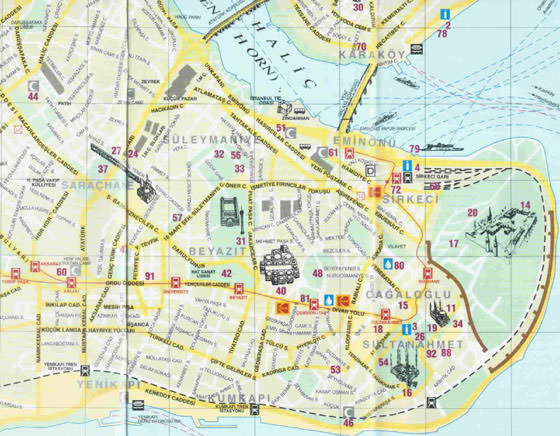
Additional maps of Istanbul
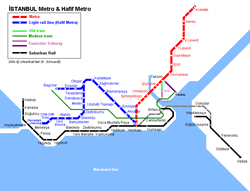
City tours, excursions and tickets in Istanbul and surroundings

Search for services, infrastructure and sights on map of Istanbul

Photogallery of Istanbul sightseeing
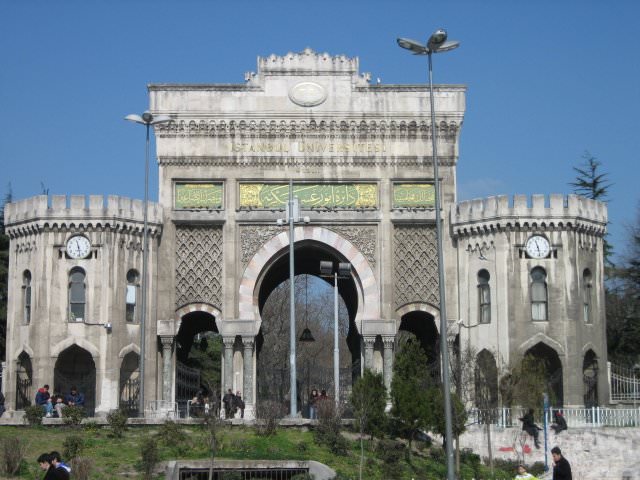
Our guide chapters over Istanbul
Travel guide to istanbul.
Review of luxury hotels
Istanbul for children - what to visit, stylish hotels, shopping, streets and outlets, hotels with history of istanbul, detailed maps of neighbouring cities to istanbul.

Istanbul Printable Tourist Map

Istanbul Map: The Attractions
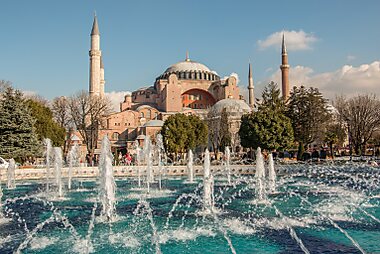
Hagia Sophia
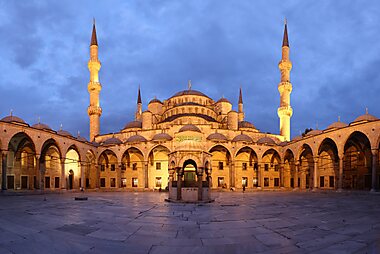
The Blue Mosque
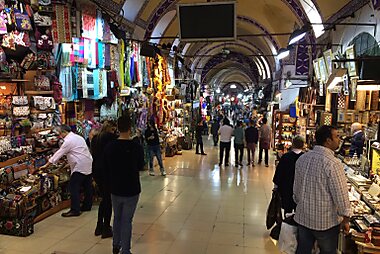
Grand Bazaar
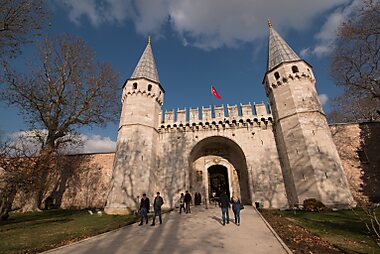
Topkapı Palace
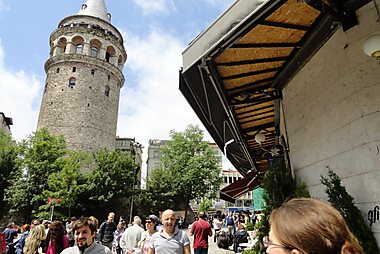
Galata Tower
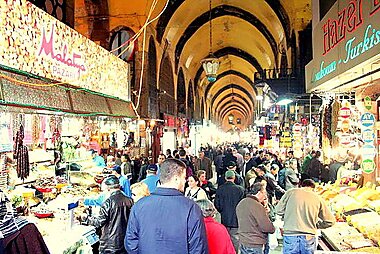
Egyptian (Spice) Bazaar

Galata Bridge
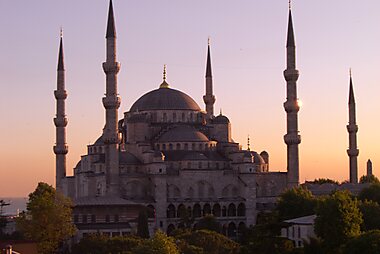
Süleymaniye Mosque
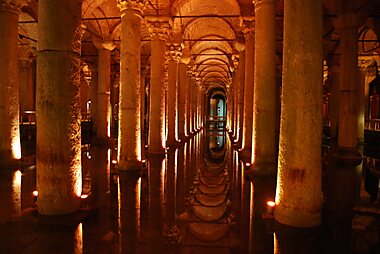
Basilica Cistern

Istiklal Street
Sygic travel - a travel guide in your pocket.

More Tourist Maps
- Privacy Policy
- STOCK 360° TRAVEL VIDEOS
Istanbul Trails ~ Your Istanbul Tourist & Expat Travel Guide
Your personal Istanbul city trip & expat guide
Printable Tourist Maps of Istanbul
The maps below are created by yours truly via Google Maps. Click on any place marker to obtain more information about the sightseeing spot. The maps are also printable, after clicking on the View Larger Map link. Keep in mind though that the information behind the different place markers will not be printed.
- Overview Map of Istanbul – Defining the Areas
- Map with Tourist Attractions in the Historical Part of Istanbul
- Map with Tourist Attractions in the Modern Part of Istanbul
- Map with Tourist Attractions beyond the City Center of Istanbul
- Map with My Favorite Restaurants in the Historical Part of Istanbul
- Map with My Favorite Restaurants in the Modern Part of Istanbul
- Map with My Favorite Cafés and Pubs in the Modern Part of Istanbul
- Map with My Favorite Cafés and Pubs in the Historical Part of Istanbul
- Map of the Scenic Bosphorus Tour Ferry Route
Leave a Comment
Stay Up To Date
- Articles via RSS
- Articles via Email
Also follow Istanbul Trails on Twitter!
- When & Why to Go
- Visa, Money & Safety
- Hotel & Area Guide
- Things To See & Do
- Transportation
- Food & Drinks Guide
- My Tips & Tricks
- Etiquette & Customs
- Istanbul Maps
- Photo Gallery
- Video Gallery
- Istanbul Facts & Figures
- Basic Turkish for Tourists
Recommended Articles
- Getting Around in Istanbul by Metro, Tram and Funicular
- The Grand Bazaar – Maze or Oriental Feast?
- Old or New Turkish Lira, What’s in the Name?
- Getting Around in Istanbul by Ferry or Sea Bus
- Does the Pierre Loti Cafe Have to Be On Your Istanbul To-Do List?
- Istanbul Cruise Ship Port and Visa Essentials
- Is Eating Istanbul’s Street Food a Wise Idea or Living Dangerously?
- Why You Should Avoid Taking a Bus in Istanbul
- Overview of the Main Tourist Areas in Istanbul
- How to Get a Turkish Visa at the Istanbul Ataturk (Atatürk) Airport?
- How To Take A Taxi In Istanbul Without Being Hustled?
- 10 Istanbul Pedestrian Safety Tips That May Be a Lifesaver
- Nevizade Sokak Is Your Safest Bet for a Great Night out in Istanbul
Hotel Deals I Recommend
Istanbul top tourist attractions city travel maps
Detailed street names english travel guide showing must-see places & best destinations to visit in europe & asia - istanbul top tourist attractions map.
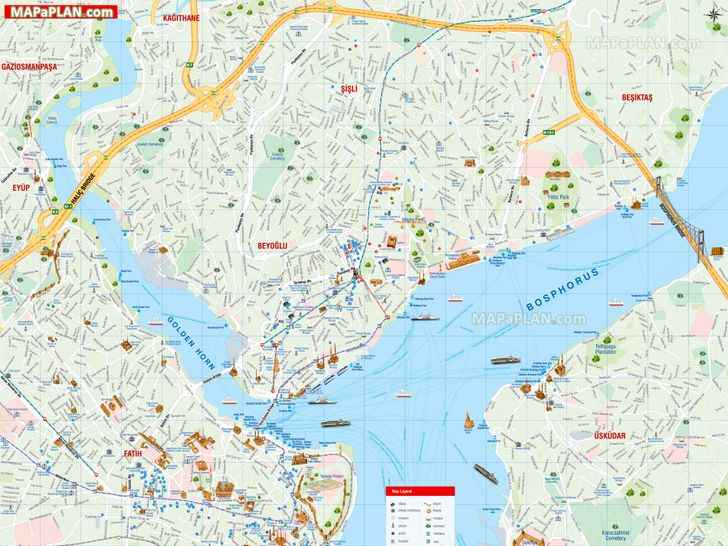
Maps of best attractions in Istanbul, Turkey
Istanbul maps will guide you to the best destinations in this magical city. Istanbul is divided by the Bosphorus Straits, making it the only city in the world on two continents. The modern district of Taksim and the historic peninsula of the Old City occupy the European side of the Bosphorus, separated by the picturesque Golden Horn estuary and connected by a number of bridges and ferries. The major sightseeing draw is over in the south in the Old City (aka the Historic Peninsula or Old Istanbul region). With the help of our maps you will be able to make the most of your trip. You can find the detailed locations of the must-see sights including Aya Sofya (Hagia Sophia), Topkapi Palace, Blue Mosque (Sultanahmet Mosque), Grand Bazaar (also know as Covered Bazaar or Kapalicarsi), Underground Basilica Cistern, Ayasofya Hurrem Sultan Hamam public bath, Cemberlitas Turkish Bath, Spice Market, Bosphorus ferry, Suleymaniye Mosque, Galata Bridge & Tower, Istanbul Archaeology Museums, Turkish and Islamic Arts Museum, Chora (Kariye) Church, Cevahir Shopping Center Mall, Dolmabahce Palace, Beylerleyi Palace, Prince's Islands, Maiden Tower, Taksim Gezi Park, Golden Horn Halic, port, nightlife night clubs, traditional restaurants, areas of Bebek, Cihandir, Karakoy, Ortakoy, Pera - just click on a selected map to access a high resolution version that can be downloaded and printed; or saved onto your mobile device.
Free inner city centre map with main landmarks, most popular sights, great art spot, mosques - Istanbul iconic tourist attractions map
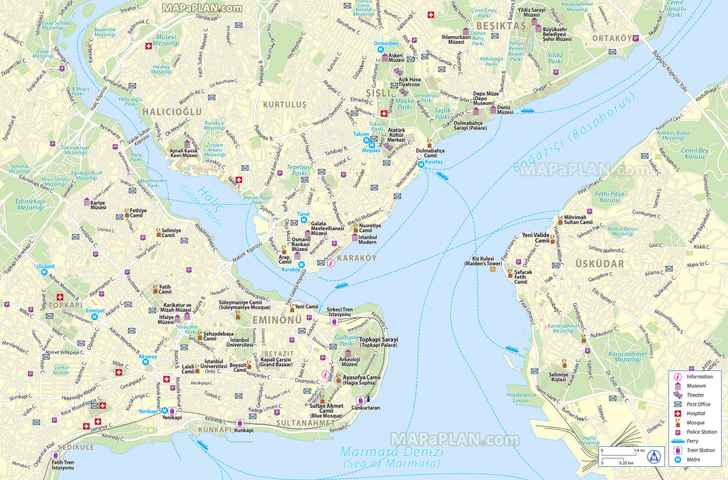
You can view, download or print a full, high resolution (detailed, large) version of this image by clicking on the plan itself
Metro (subway, tube), railway train stations & trams - Istanbul Metrosu Ulasim LRT Lirgt Rapid Transit network system showing ferry & Ataturk Airport Terminal - Istanbul jpg map
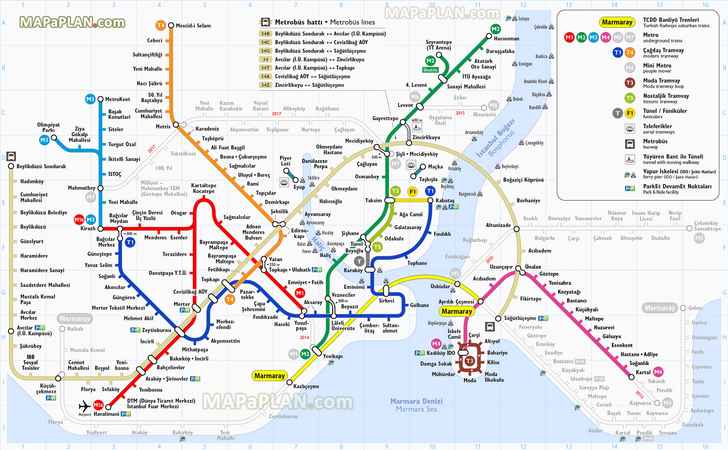
Big Bus city sightseeing hop-on hop-off double decker open top coach tour stops near Bosphorus, Taksim Sqaure, Fatih - Map of Istanbul tourist attractions
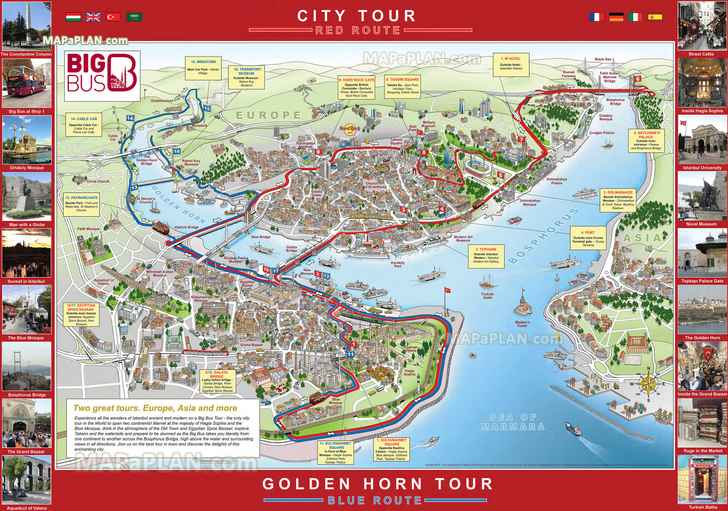
One day itinerary to explore major points of interest & central sites worth visiting including Spice Market, Topkapi Palace - Istanbul free city map
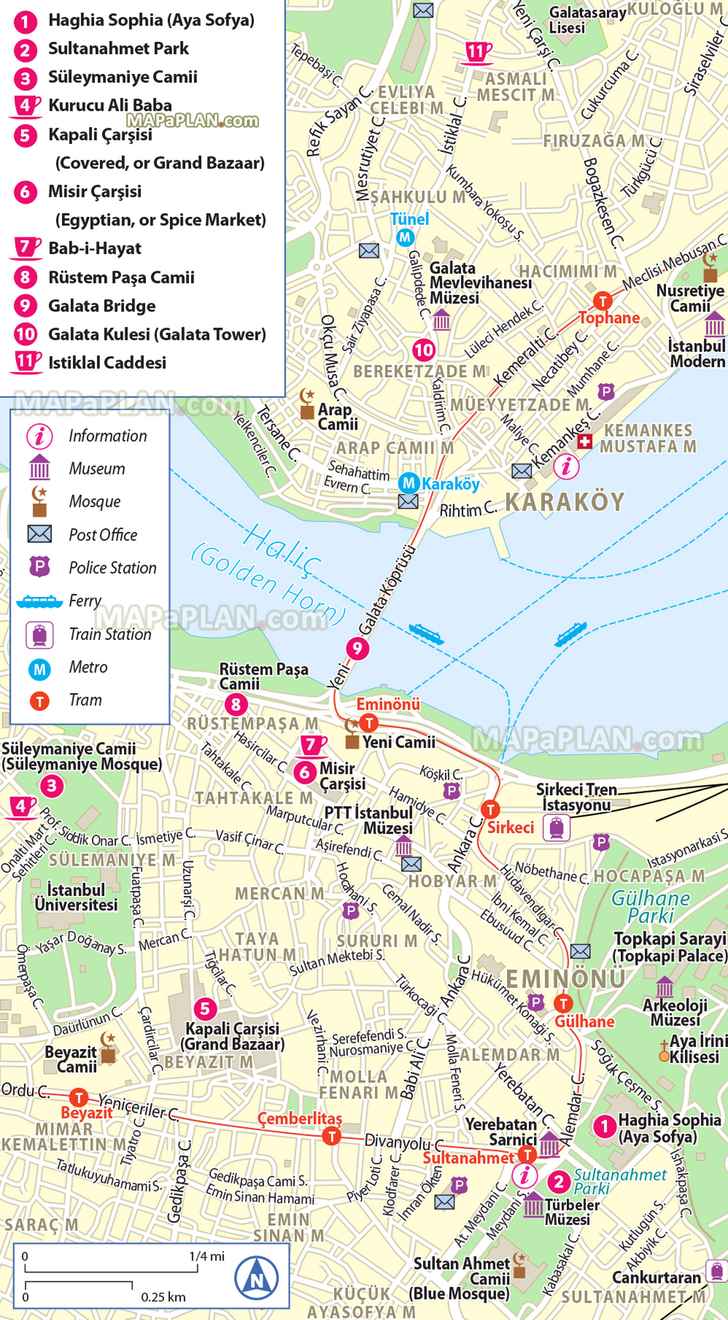
Grand Bazaar (Kapalicarsi) shops overview showing covered roads shopping for jewelry, leather - Istanbul printable sightseeing map
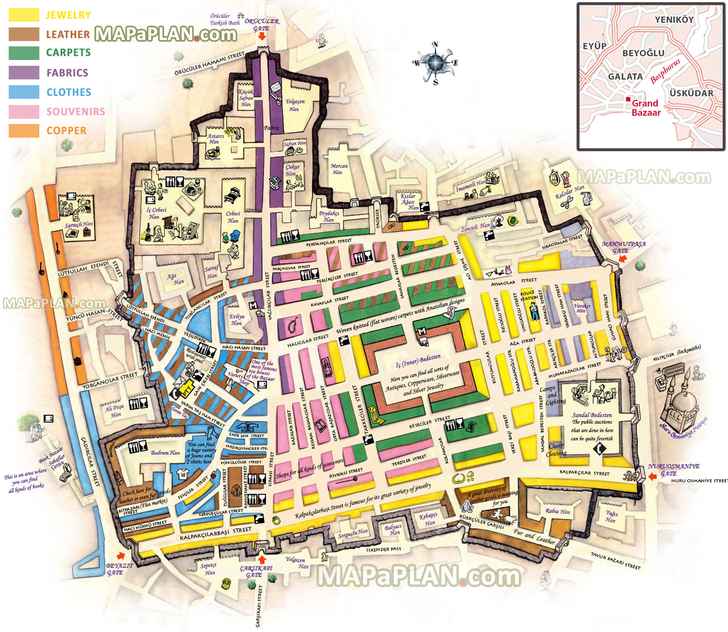
Aya Sofia (Hagia Sophia) museum, church & mosque monuments - Visitor guide - Floor plan simple outline diagram - Istanbul large scale map
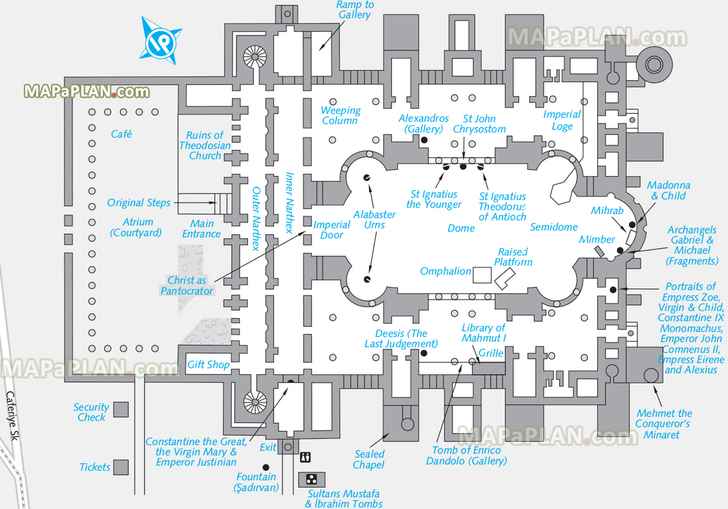
Old town & Downtown area list of must-do hotspots including Blue Mosque, Undeground Cistern & official tourist information office - Istanbul offline map
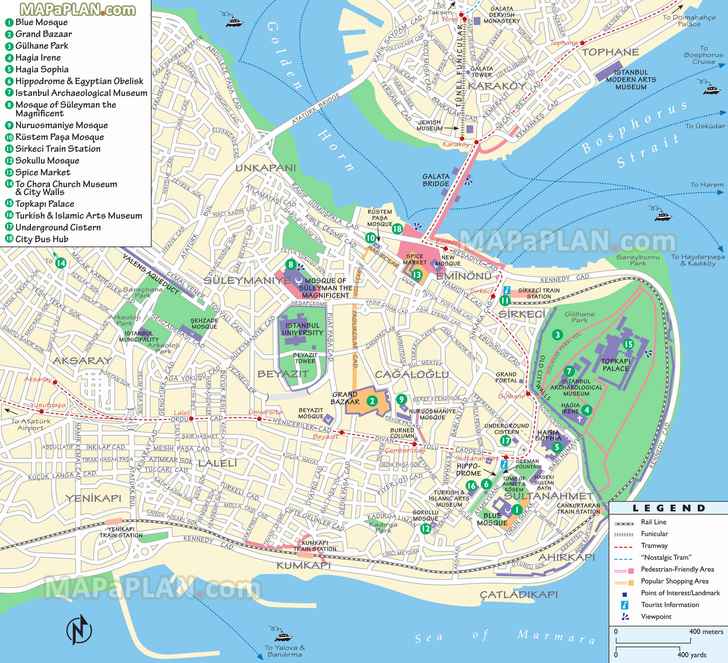
Bird's eye aerial 3d virtual interactive view poster of favourite historical locations & famous buildings - Istanbul pop up map
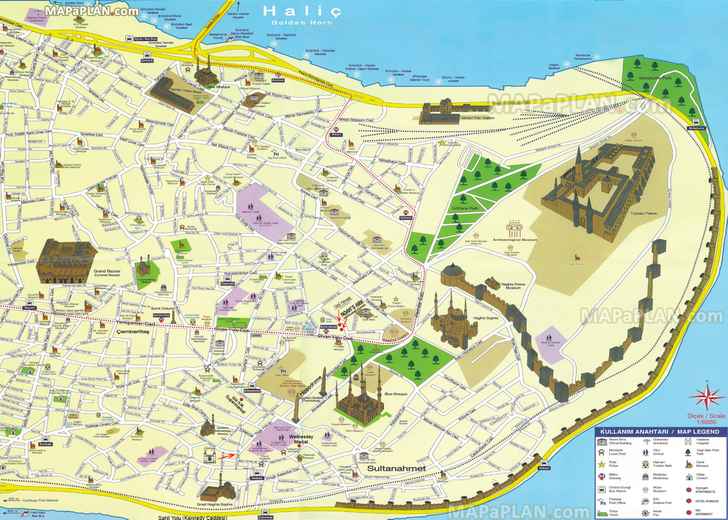
Three-day trip list of attractions - What to see, where to go, what to do in neighbourhood Districts of Beyoglu, Besiktas, Eminonu, Harbiye - Istanbul online map
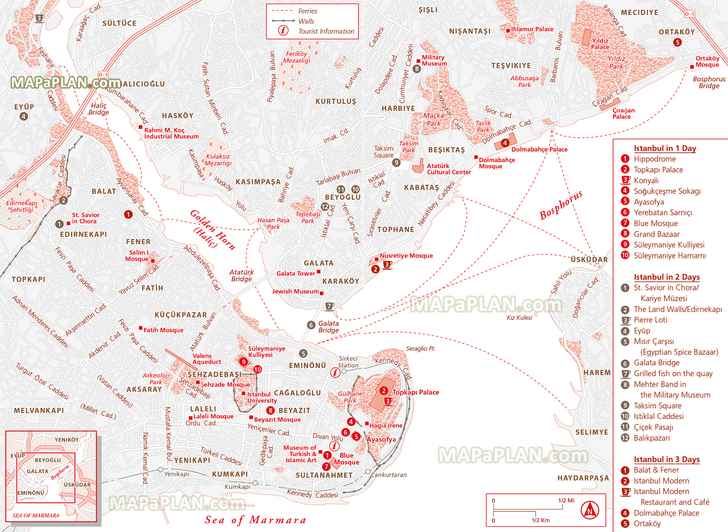

Historic penisula showing Sultanahmet, Aksaray, Suleymaniye, Galata Bridge, Archaeology Museum, Hippodrome - Istanbul simple map
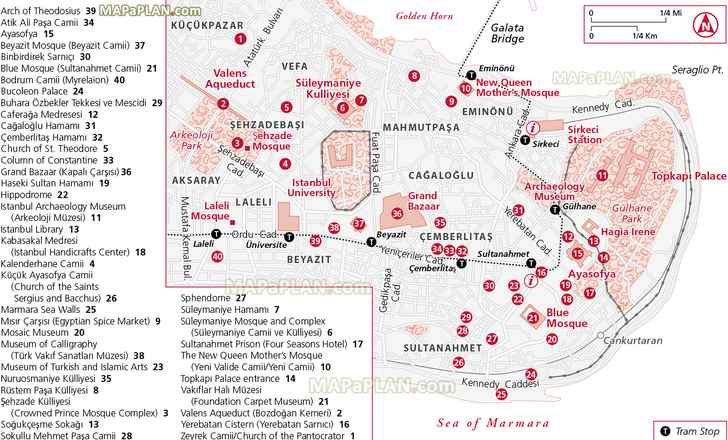
Underground walking tour trail directions route planner with fun things to do with family & kids - Istanbul tourist guide map
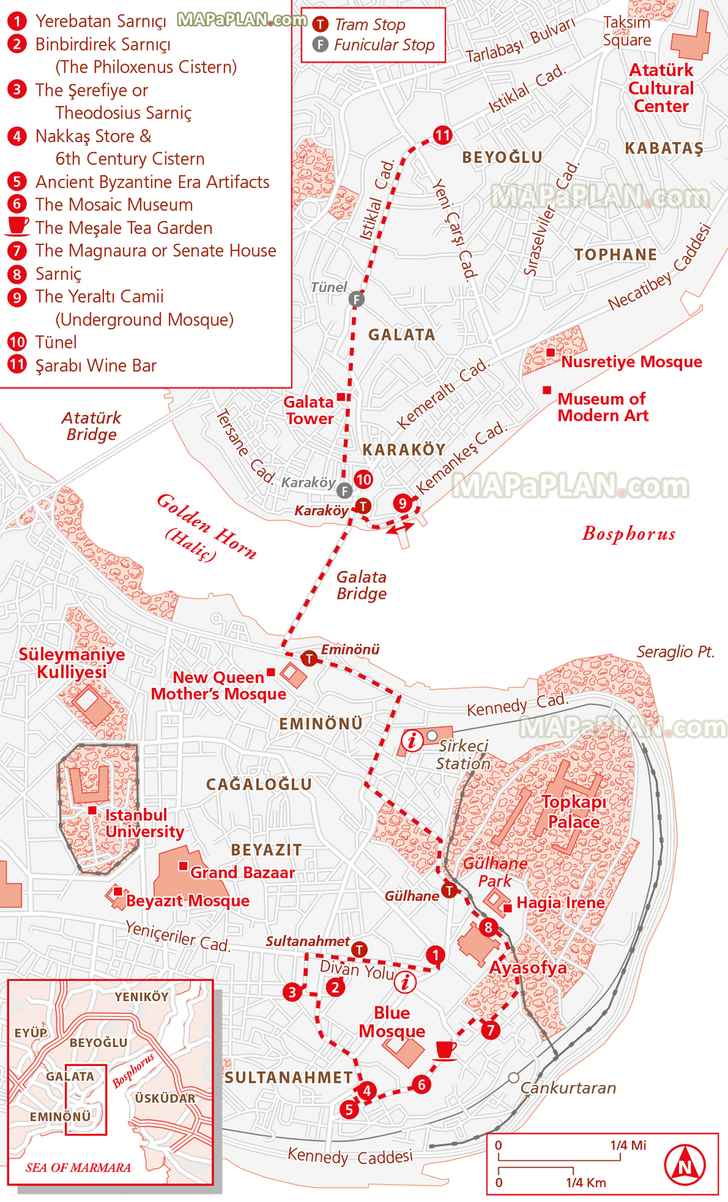
Map of top 10 attractions in Istanbul
The typical top ten attractions are listed below. You can find the detailed locations of these places on the maps above.
- Visit the Blue Mosque (Sultanahmet Mosque) - This landmark mosque assumes a stance of authority over Sultanahmet Park. Just under the dome, hundreds of stained-glass windows sparkle like jewels until you are convinced that you're in the presence of a celestial being. The blue of the mosque actually changes to yellow, orange, and red, depending on the time of day and the entrance you choose to use.
- Visit Aya Sofya (Hagia Sophia) - When faced with the dome of this masterpiece, it's tempting to mimic the actions of Mehmet the Conqueror almost 600 years ago and drop to your knees in a gesture of utter humility. The sensation is intensified by the low level of filtered light that finds its way in, temporarily blinding you to everything except the source of illumination.
- Take a hamam - The Turkish bath, rising out of the Islamic requirement of cleanliness, is not just practical; it's relaxing as well. A good hamam experience includes the proper traditional ambience and a heavy-handed scrubbing. For historical value and pomp, you can't beat the Cemberlitas Hamami and the Ayasofya Hurrem Sultan Hamam, or for luxury, one of the many deluxe hotel accommodation hamams.
- Discover the Grand Bazaar (Covered Bazaar or Kapalicarsi) - Nobody should pass through Turkey without spending a day at the mother of all shopping malls. The atmosphere crackles with the electricity of the hunt - but are you the hunter or the hunted? The excitement is tangible, even if you're on the trail of a simple pair of elf shoes or an evil-eye talisman. When the salesman turns away from you in disgust, you've learned the bottom price for an item.
- Taki a boat ferry cruise ride up the Bosphorus - Nowhere else in the world can you cross to another continent every 15 minutes. Connecting trade routes from the East to the West, it's no surprise that any conqueror who was anybody had his sights set on the Bosphorus.
- Visit the Topkapi Palace - This was once somebody's house. Actually, it was the home of a whole lot of people - up to 5,000 at a time, all in the service of one man. The sultan surrounded himself with the most beautiful women in the world. He collected the most precious treasures of the East. He assembled the most sacred relics of the Muslim faith under this roof. Six hundred years of Ottoman history lies behind these grand ornamental gates.
- Take a journey back in time in the Istanbul Archaeology Museum - This is one of those must-see museums that all too many overlook. It's actually the largest museum in the country, chronicling in stone both the lives of Byzantium's emperors and of Istanbul.
- Cross the Galata Bridge on foot - Fishermen line the railings above, while dinner (or tea, or backgammon) is served below as the majestic and inspiring silhouettes of the Suleymaniye Mosque, Rustem Pasa, and Yeni Camii loom in the distance. If you wait until after sunset, you get to see the seagulls circling the minarets.
- Stroll through the subterranean Basilica Cistern water reservoir - Your visit to the dimly lit, cavernous chamber includes two stone Medusa heads recycled from earlier Roman structures. The cistern also hosts occasional concerts of traditional Turkish and classical Western music.
- Visit the Suleymaniye Mosque - The architect Sinan's 14th-century masterpiece, known for its serene interior and the tombs of Süleyman and his wife Roxelana.
What are some interesting facts about Istanbul?
Istanbul is the only city in the world to straddle two continents but still worth mentioning. The historic centre lies on the European side of the city. The Bosphorus Strait divides the European and Asian sides and is the link between the Black Sea and the Sea of Marmara.
Istanbul, which used to be known as Constantinople thanks to the Roman Emperor Constantine the Great, is built on seven hills to match the seven hills of Rome.
Under the Ottoman Empire, the city was renowned for having more than 1,400 public toilets.
The Grand Bazaar is the biggest old covered bazaar in the world, with over 3,000 shops.
British author Agatha Christie wrote her famous novel 'Murder on the Orient Express' at Pera Palas Hotel in Istanbul.
Istanbul has been the capital of some of the biggest empires: Roman, Byzantine, Latin and Ottoman. It is now Turkey's largest city with over 13 million people – more than the population of Belgium – and the second largest in the world by population within city limits. However, it's not Turkey's capital. Ankara has been the capital since Turkey was proclaimed a republic by Mustafa Kemal Atatürk in 1923.
The Blue Mosque is the only mosque in the city with six minarets. Legend has it that when it was built, it had one minaret more than the Grand Mosque in Mecca (four was the common maximum at that time) and this was considered disrespectful in the Muslim world. In order to solve the issue, one more minaret had to be added to the Grand Mosque.
Hagia Sophia was the largest church in the world for about 900 years until Seville Cathedral was completed in 1520. It was also one of the 20 finalists for the New 7 Wonders of the World.
The four bronze horses decorating the San Marco Cathedral in Venice were taken from Istanbul (Constantinople at that time) by the crusaders in the 13th century.
Related keywords
2023, 2024, 2025, 2025, 2026, 2027, 2028, 2029, download, print, printable, free, detailed, aerial, bird's eye, guide, map, plan, planner, travel, sightseeing, visit, trip, tour, tourist, what to do, where to go, things to do, must see, top attractions, points of interest, places, sites, sights, buildings, spots, destinations, locations, landmark, museum, in a week, in 3 days, one day, city, route, bus, kids, children, top 10, top ten, popular, famous, interesting, highlights, public transport, rail, hotels, metro, subway, underground, tube
Seating plans and charts of entertainment venues showing detailed seat and row numbers
- Aberdeen P&J Live seating diagram with row numbers
- Amsterdam Johan Cruijff ArenA seating diagram with row numbers
- Amsterdam Ziggo Dome Arena seating diagram with row numbers
- Anaheim Honda Center seating diagram with row numbers
- Antwerpen Lotto Arena seating diagram with row numbers
- Antwerpen Sportpaleis seating diagram with row numbers
- Atlanta Mercedes-Benz Stadium seating diagram with row numbers
- Atlanta State Farm Arena seating diagram with row numbers
- Auckland Eden Park Stadium seating diagram with row numbers
- Auckland Go Media Mount Smart Stadium seating diagram with row numbers
- Auckland Spark Arena seating diagram with row numbers
- Barcelona Palau Sant Jordi seating diagram with row numbers
- Belfast Odyssey SSE Arena seating diagram with row numbers
- Belfast Ravenhill Uster Rugby Kingspan Stadium seating diagram with row numbers
- Belfast Windsor Park National Football Stadium seating diagram with row numbers
- Belmont Park Elmont UBS Arena seating diagram with row numbers
- Berlin Olympiastadion seating diagram with row numbers
- Berlin Uber Arena seating diagram with row numbers
- Birmingham Resorts World Arena NEC seating diagram with row numbers
- Birmingham Utilita Arena NIA seating diagram with row numbers
- Boston TD Garden seating diagram with row numbers
- Brighton Centre seating diagram with row numbers
- Brisbane Gabba Cricket Ground seating diagram with row numbers
- Brussels ING Arena seating diagram with row numbers
- Brussels King Baudouin Stadium seating diagram with row numbers
- Brussels Vorst Nationaal Forest National seating diagram with row numbers
- Buffalo KeyBank Center seating diagram with row numbers
- Calgary Scotiabank Saddledome seating diagram with row numbers
- Cardiff International Utilita Arena seating diagram with row numbers
- Cardiff Millennium Principality Stadium seating diagram with row numbers
- Carrara People First Stadium seating diagram with row numbers
- Charlotte Bank of America Stadium seating diagram with row numbers
- Charlotte Spectrum Center seating diagram with row numbers
- Chicago Soldier Field seating diagram with row numbers
- Chicago United Center seating diagram with row numbers
- Cincinnati Paycor Stadium seating diagram with row numbers
- Cleveland Browns Stadium seating diagram with row numbers
- Cologne Lanxess Arena seating diagram with row numbers
- Cologne RheinEnergieStadion Stadion Köln seating diagram with row numbers
- Columbus Nationwide Arena seating diagram with row numbers
- Copenhagen Royal Arena seating diagram with row numbers
- Dallas American Airlines Center seating diagram with row numbers
- Dallas AT&T Stadium seating diagram with row numbers
- Denver Ball Arena seating diagram with row numbers
- Denver Empower Field at Mile High seating diagram with row numbers
- Derby Velodrome Arena seating diagram with row numbers
- Detroit Ford Field seating diagram with row numbers
- Detroit Little Caesars Arena seating diagram with row numbers
- Dortmund Westfalenhalle seating diagram with row numbers
- Dublin 3Arena seating diagram with row numbers
- Dublin Aviva Stadium seating diagram with row numbers
- Dublin Croke Park Stadium seating diagram with row numbers
- Dusseldorf Merkur Spiel-Arena seating diagram with row numbers
- East Rutherford MetLife Stadium seating diagram with row numbers
- Edinburgh Scottish Gas Murrayfield Stadium seating diagram with row numbers
- Edmonton Northlands Coliseum seating diagram with row numbers
- Edmonton Rogers Place seating diagram with row numbers
- Fairfax EagleBank Arena seating diagram with row numbers
- Foxborough Gillette Stadium seating diagram with row numbers
- Frankfurt am Main Deutsche Bank Park Waldstadion seating diagram with row numbers
- Frankfurt am Main Festhalle seating diagram with row numbers
- Gdańsk-Sopot Ergo Arena seating diagram with row numbers
- Gelsenkirchen Veltins Arena AufSchalke seating diagram with row numbers
- Glasgow OVO Hydro Arena seating diagram with row numbers
- Glendale Desert Diamond Arena seating diagram with row numbers
- Glendale State Farm Stadium seating diagram with row numbers
- Hamburg Barclays Arena seating diagram with row numbers
- Hamburg Volksparkstadion seating diagram with row numbers
- Hannover Heinz von Heiden Arena Niedersachsenstadion seating diagram with row numbers
- Hannover ZAG Arena seating diagram with row numbers
- Hasselt Trixxo Arena seating diagram with row numbers
- Houston NRG Stadium seating diagram with row numbers
- Indianapolis Gainbridge Fieldhouse seating diagram with row numbers
- Indianapolis Lucas Oil Stadium seating diagram with row numbers
- Jacksonville EverBank Stadium seating diagram with row numbers
- Kansas City GEHA Field Arrowhead Stadium seating diagram with row numbers
- Katowice Spodek seating diagram with row numbers
- Kraków Tauron Arena seating diagram with row numbers
- Las Vegas Allegiant Stadium seating diagram with row numbers
- Las Vegas Sphere seating diagram with row numbers
- Las Vegas T-Mobile Arena seating diagram with row numbers
- Leeds First Direct Arena seating diagram with row numbers
- Liverpool FC Anfield Stadium seating diagram with row numbers
- Liverpool M&S Bank Arena seating diagram with row numbers
- Łódź Atlas Arena seating diagram with row numbers
- London Arsenal Emirates Stadium seating diagram with row numbers
- London O2 Arena seating diagram with row numbers
- London Royal Albert Hall seating diagram with row numbers
- London Stadium (West Ham United Olympic Park) seating diagram with row numbers
- London Tottenham Hotspur Stadium seating diagram with row numbers
- London Twickenham Stadium seating diagram with row numbers
- London Wembley OVO Arena seating diagram with row numbers
- London Wembley Stadium seating diagram with row numbers
- Los Angeles Crypto.com Staples Center Arena seating diagram with row numbers
- Los Angeles Kia Forum Inglewood seating diagram with row numbers
- Los Angeles SoFi Stadium seating diagram with row numbers
- Louisville KFC Yum! Center seating diagram with row numbers
- Madrid Estadio Civitas Metropolitano Stadium seating diagram with row numbers
- Madrid Santiago Bernabeu Estadio Stadium seating diagram with row numbers
- Madrid WiZink Center seating diagram with row numbers
- Manchester AO Arena seating diagram with row numbers
- Manchester Co-op Live seating diagram with row numbers
- Melbourne Marvel Stadium seating diagram with row numbers
- Melbourne Rod Laver Arena seating diagram with row numbers
- Memphis FedExForum seating diagram with row numbers
- Miami Hard Rock Stadium seating diagram with row numbers
- Miami Kaseya Center Arena seating diagram with row numbers
- Milwaukee Fiserv Forum seating diagram with row numbers
- Minneapolis Target Center seating diagram with row numbers
- Minneapolis U.S. Bank Stadium seating diagram with row numbers
- Montreal Bell Centre seating diagram with row numbers
- Munich Bayern Allianz Arena seating diagram with row numbers
- Munich Olympiahalle seating diagram with row numbers
- Munich Olympiastadion seating diagram with row numbers
- Nashville Bridgestone Arena seating diagram with row numbers
- Nashville Nissan Stadium seating diagram with row numbers
- New Orleans Caesars Superdome seating diagram with row numbers
- New Orleans Smoothie King Center seating diagram with row numbers
- New York Barclays Center seating diagram with row numbers
- New York Madison Square Garden seating diagram with row numbers
- Newark Prudential Center seating diagram with row numbers
- Newcastle Utilita Arena seating diagram with row numbers
- Nottingham Motorpoint Arena seating diagram with row numbers
- Oakland Oracle Arena seating diagram with row numbers
- Oberhausen Rudolf Weber Arena seating diagram with row numbers
- Oklahoma City Paycom Center Arena seating diagram with row numbers
- Orchard Park Highmark Stadium seating diagram with row numbers
- Orlando Camping World Stadium seating diagram with row numbers
- Orlando Kia Center seating diagram with row numbers
- Oslo Spektrum Arena seating diagram with row numbers
- Oslo Telenor Arena seating diagram with row numbers
- Ottawa Canadian Tire Centre seating diagram with row numbers
- Perth HBF Park Rectangular Stadium seating diagram with row numbers
- Perth HBF Stadium Superdrome seating diagram with row numbers
- Perth Optus Stadium seating diagram with row numbers
- Perth RAC Arena seating diagram with row numbers
- Philadelphia Lincoln Financial Field seating diagram with row numbers
- Philadelphia Wells Fargo Center seating diagram with row numbers
- Phoenix Footprint Center Arena seating diagram with row numbers
- Pittsburgh Acrisure Stadium seating diagram with row numbers
- Pittsburgh PPG Paints Arena seating diagram with row numbers
- Portland Moda Center seating diagram with row numbers
- Prague O2 Arena seating diagram with row numbers
- Queensland Country Bank Stadium seating diagram with row numbers
- Raleigh PNC Arena seating diagram with row numbers
- Rosemont Allstate Arena seating diagram with row numbers
- Sacramento Golden 1 Center seating diagram with row numbers
- Saint Paul Xcel Energy Center seating diagram with row numbers
- Salt Lake City Delta Center seating diagram with row numbers
- San Antonio Frost Bank Center seating diagram with row numbers
- San Diego Snapdragon Stadium seating diagram with row numbers
- San Francisco Chase Center seating diagram with row numbers
- San Jose SAP Center seating diagram with row numbers
- Santa Clara Levi's Stadium seating diagram with row numbers
- Seattle Climate Pledge Arena seating diagram with row numbers
- Seattle Lumen Field seating diagram with row numbers
- Sevilla Estadio La Cartuja Stadium seating diagram with row numbers
- Sheffield Utilita Arena seating diagram with row numbers
- St. Louis Enterprise Center seating diagram with row numbers
- Stockholm Avicii Globe Arena seating diagram with row numbers
- Stockholm Stockholmsarenan Tele2 Arena seating diagram with row numbers
- Stockholm Strawberry Friends Arena seating diagram with row numbers
- Stuttgart MHP Arena seating diagram with row numbers
- Stuttgart Porsche Arena seating diagram with row numbers
- Sunderland Stadium of Light seating diagram with row numbers
- Sunrise FLA Live Arena seating diagram with row numbers
- Sydney Qudos Bank Arena seating diagram with row numbers
- Sydney Showground Engie Stadium seating diagram with row numbers
- Tampa Amalie Arena seating diagram with row numbers
- Tampa Raymond James Stadium seating diagram with row numbers
- Tempe Mullett Arena seating diagram with row numbers
- Toronto Rogers Centre seating diagram with row numbers
- Toronto Scotiabank Arena seating diagram with row numbers
- Tulsa BOK Center seating diagram with row numbers
- Uncasville Mohegan Sun Arena seating diagram with row numbers
- Valencia Estadio Ciudad Stadium seating diagram with row numbers
- Vancouver BC Place seating diagram with row numbers
- Vancouver Rogers Arena seating diagram with row numbers
- Vienna Ernst Happel Stadion seating diagram with row numbers
- Vienna Wiener Stadthalle seating diagram with row numbers
- Warszawa PGE Stadion Narodowy seating diagram with row numbers
- Washington DC Capital One Arena Center seating diagram with row numbers
- Wellington TSB Arena seating diagram with row numbers
- Winnipeg Canada Life Centre seating diagram with row numbers
- Zürich Oerlikon Hallenstadion seating diagram with row numbers
- Zürich Stadion Letzigrund seating diagram with row numbers
High resolution, printable travel guide maps of cities showing top tourist attractions
- Amsterdam top points of interest map
- Bangalore top points of interest map
- Bangkok top points of interest map
- Barcelona top points of interest map
- Beijing top points of interest map
- Berlin top points of interest map
- Bruges top points of interest map
- Brussels top points of interest map
- Budapest top points of interest map
- Cambridge top points of interest map
- Chicago top points of interest map
- Copenhagen top points of interest map
- Delhi top points of interest map
- Dubai top points of interest map
- Dublin top points of interest map
- Edinburgh top points of interest map
- Florence top points of interest map
- Frankfurt top points of interest map
- Hong Kong top points of interest map
- Istanbul top points of interest map
- Jaipur top points of interest map
- Las Vegas top points of interest map
- Lisbon top points of interest map
- London top points of interest map
- Los Angeles top points of interest map
- Madrid top points of interest map
- Malaga top points of interest map
- Marrakech top points of interest map
- Miami top points of interest map
- Milan top points of interest map
- Mumbai top points of interest map
- New York top points of interest map
- Oxford top points of interest map
- Paris top points of interest map
- Prague top points of interest map
- Rome top points of interest map
- San Francisco top points of interest map
- Singapore top points of interest map
- Sydney top points of interest map
- Tokyo top points of interest map
- Venice top points of interest map
- Vienna top points of interest map
- Washington DC top points of interest map
- Zurich top points of interest map
Map - Interactive Istanbul Map
Information about the map.
Check out the main monuments, museums, squares, churches and attractions in our map of Istanbul. Click on each icon to see what it is.
To help you find your way once you get to your destination, the map you print out will have numbers on the various icons that correspond to a list with the most interesting tourist attractions. This way, you’ll be able to see where each attraction is.
Icons on the Istanbul interactive map
The map is very easy to use:
- Check out information about the destination: click on the color indicators.
- Move across the map: shift your mouse across the map.
- Zoom in: double click on the left-hand side of the mouse on the map or move the scroll wheel upwards.
- Zoom out: double click on the right-hand side of the mouse on the map or move the scroll wheel downwards.
You may also be interested in
Istanbul has a large number of hotels to suit any budget and, although prices have gone up plenty in recent years, it's still possible to find some fantastic offers when looking for where to stay.
Information
You can find all the information you need to plan your trip to Istanbul. Discover interesting information about the currency, language, prices and their history.
Buy & Save 30% Now
GET FREE 1GB Internet
Starting from just €29 per day!
Browse Attractions on Our Interactive Map
Istanbul is an enormous city with a lot of things to see, that's why we created this interactive map to ease your transportation! Simply zoom in or out of the map to find the attractions that you would like to attend and create your itinerary based on their distance. Enjoy 100+ popular attractions with Istanbul Tourist Pass®️!

1 2 3 4 5 4.8 out of 5 stars
Istanbul Tourist Pass® has an average rating of 4.8 /5 from 1405 reviews
How it works?
Istanbul tourist pass®, work with us, other links, popular attractions.
- Hagia Sophia
- Topkapi Palace
- Dolmabahce Palace
- Basilica Cistern
- Turkish & Islamic Arts Museum
- Blue Mosque
- Grand Bazaar
- Galata Tower
- Maiden's Tower
- Suleymaniye Mosque
- Bosphorus Dinner Cruise
- Whirling Dervishes Show
- Madame Tussauds
- Sea Life Aquarium
- Zippline Nakkastepe
- Istanbul Airport Shuttle
- Istanbul Transportation Card
- Private Airport Transfer
- Unlimited Internet Access
- Whatsapp Instant Support
- View All 100+
- Skip to main content
- Skip to secondary menu
- Skip to primary sidebar
- Skip to footer
Istanbul Travel Blog
An Insider's Guide to Istanbul
- Istanbul Metro & Tram Map PDF [Free Download 2024]
18 May 2024 by Serhat Engul
The public transportation network in Istanbul has developed rapidly in recent years. In this article, you can find the tram, ferry and metro map of Istanbul updated for 2024. There are links to full resolution maps in the article, as well as downloadable PDF files (for free).
For those who visit Istanbul, it is essential to visit Sultanahmet (Old City), Beyoglu (Taksim), Besiktas (Bosphorus) and Kadikoy (Asian Side). In this article, you can find all the information you need to travel between these four tourist spots without the need for a taxi.
Table of Contents
Istanbul Public Transportation Map 2024
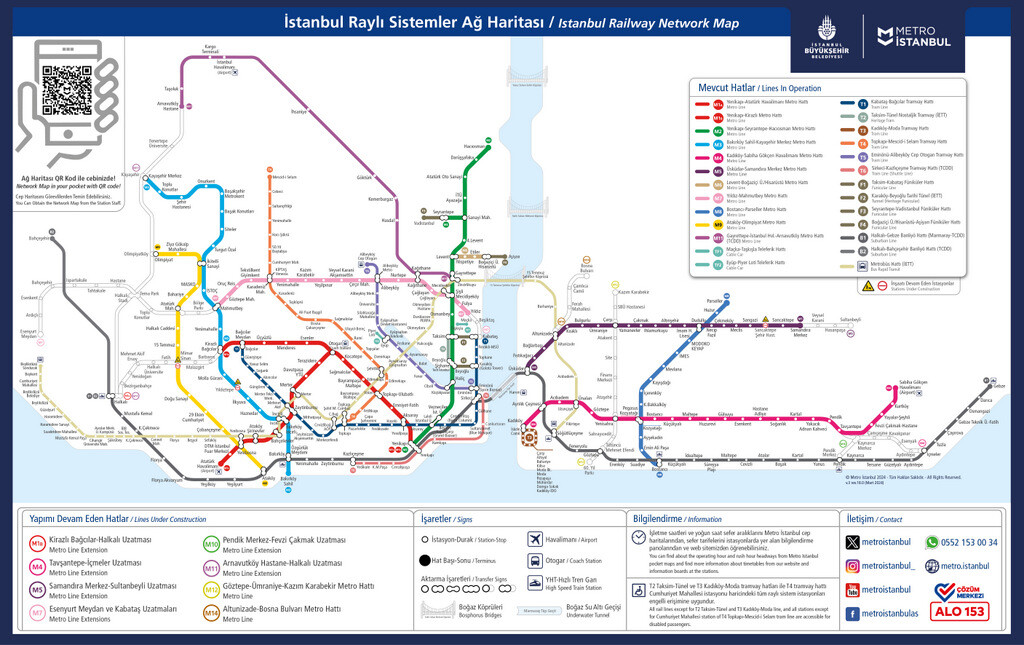
First of all, I want to introduce you to the most used public transportation vehicles in Istanbul . In the following lines, I will explain how you can use vehicles such as Tram, Metro, Marmaray, Metrobus and Ferry efficiently.
I uploaded the maps in low resolution so they wouldn’t slow down the page opening speed. However, you can immediately access the high resolution and printable PDF versions of these maps under the relevant headings. I hope it will be useful to you.
It’s strongly recommended to use public transport all the time if possible, as Istanbul’s traffic is one of the worst in the world during the rush hours. The busiest hours in Istanbul are between 7 and 10 in the morning and between 6 and 9 in the evening.
You can download the Istanbul Public Transportation Map as PDF file from this link .
1. Istanbul Metro Map 2024
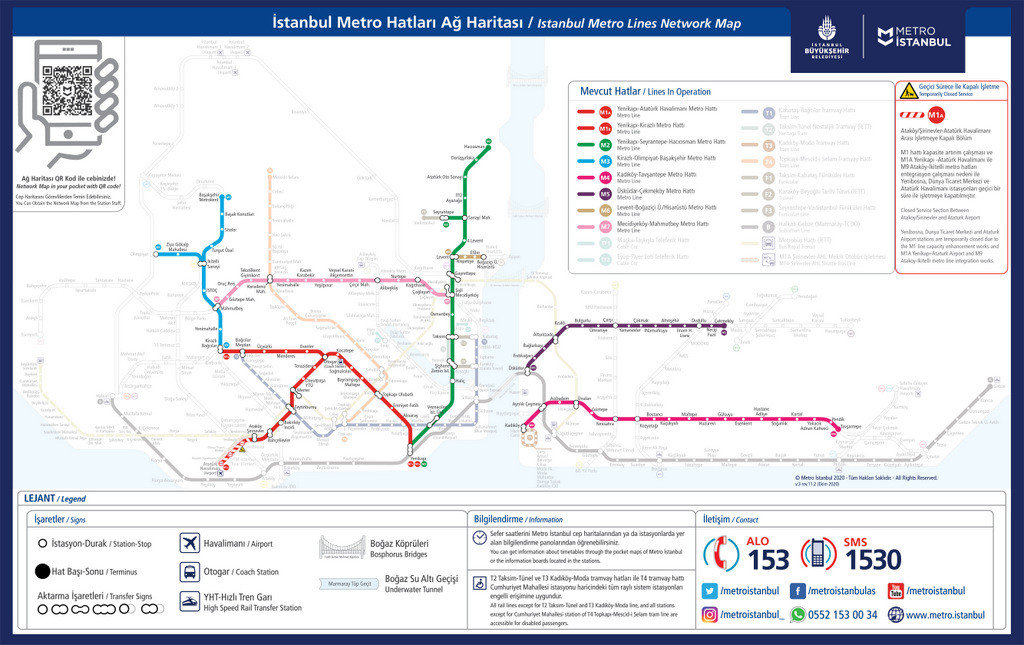
The most important destinations on the Istanbul Metro Map are Yenikapi , the public transportation hub of the Old City, Taksim Square , the heart of Modern Istanbul, and Kadikoy , the public transportation center of the Asian Side.
The metro line most used by tourists is the M2, which runs from the Old City to Taksim and beyond and covers business centers and large shopping malls, and is marked in dark green.
If you go to the Asian side of the city, the M4 line marked in pink will take you to Sabiha Gokcen Airport, the second airport of Istanbul. You can also reach the most popular shopping malls and hotels on the Asian Side via the M4 metro.
You can also find the Istanbul Metro Map as a printable PDF file from this link .
2. Istanbul Tram Map 2024
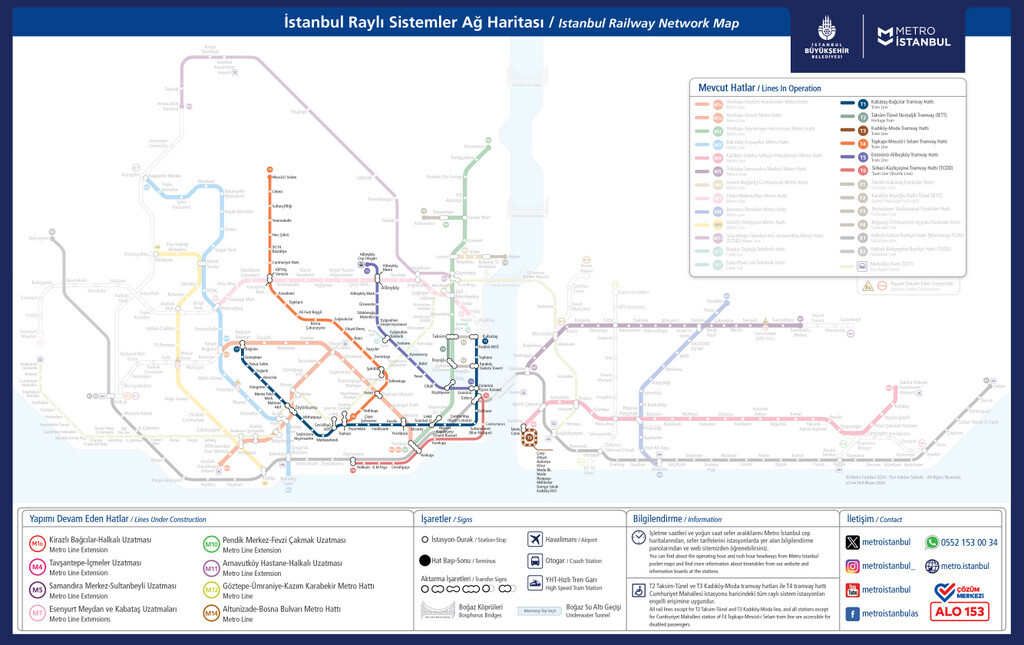
Istanbul Tram Map covers the most important tourist centers of the city. Especially Tram T1 is extremely efficient and handy to commute between the Old City (Sultanahmet, Sirkeci, Eminonu) and the Beyoglu (Karakoy, Galata, Taksim Square).
Major Tram Stops In the Old City
The major tram stations in the Old City cover the most important historical monuments that most tourists would like to see. Historical monuments can be reached on foot from tram stops in 10 minutes.
Beyazit (Grand Bazaar), Cemberlitas (Forum of Constantine), Sultanahmet (Blue Mosque and Hagia Sophia), Gulhane (Archaeological Museum), Sirkeci (Marmaray Train Station), Eminonu (Spice Bazaar).
After Eminonu , the tram crosses the Galata Bridge and thus you will cross the Golden Horn to the north side. The first stop in this relatively new district of the city will be Karakoy .
Major Tram Stops In the New City
Major tram stations in New City connect you to places like Galataport (Istanbul’s Cruise Port), Istanbul Museum of Modern Art, Galata Tower and Dolmabahce Palace. These stops are as follows, starting with the one closest to the Old City (and Galata Bridge):
Karakoy (Galata Tower), Tophane (Galataport Cruise Terminal), Findikli (Mimar Sinan University), Kabatas (Funicular Connection for Taksim Square).
Tram is enough for someone who will stay in Istanbul for a day or two. You can visit the most important sights by using the Tram T1 line. You can also walk to Dolmabahce Palace from Kabatas, the last stop of the tram.
You can find the Istanbul Tram Map as a printable PDF file from this link
3. Istanbul Marmaray Map 2024
Istanbul Marmaray Map that I shared above contains a yellow line. You can see that you can travel from one end of the city to the other with Marmaray by following this yellow line.
Marmaray allows you to travel quickly from the European side of Istanbul to the Asian side. You can cross the Bosphorus in 20-25 minutes by ferry, but in just a few minutes with Marmaray.
In this way, you can reach Uskudar in 4 minutes and Kadikoy in 8 minutes, which are the most popular spots on the Asian Side of Istanbul. I give these times according to Sirkeci Station in Istanbul Old City.
You can view the Istanbul Marmaray Map as a PDF file from this link .
4. Istanbul Metrobus Map 2024
Istanbul Metrobus Map includes the districts that are on the outer edges of the city and are generally not very touristic. The brown line, starting from Sogutlucesme on the Asian Side and ending in Beylikduzu on the European side, represents the Metrobus line.
Roads that lead to Bosphorus Bridge (1st bridge) is always busy. The folk travelling from Asian Side to European Side had hard times passing through the bridge with regular bus. Therefore Istanbul Metropolitan Municipality built some special lanes for the Metrobus and put comfortable busses into operation.
Metrobus travel all around Istanbul’s fringes. It provides fast journey that saves you from traffic jams in Istanbul. However, Metrobus is packed with people during rush hours!
Although the metrobus line seems a bit confusing at first glance, Metrobus is often a necessary means of transportation. Because it’s very difficult to reach some congress centers and fairs of Istanbul without a metrobus.
You can view the Istanbul Metrobus Map as PDF by clicking here .
5. Istanbul Ferry Map 2024
Istanbul Ferry Map shows us the locations of Istanbul’s nostalgic ferries and tour boats. These sea transport vehicles allow us to travel between the European and Asian sides as well as take a Bosphorus cruise.
For example, piers 1, 2 and 5 on the map show tour boats making a Bosphorus cruise . Pier 1 belongs to the Turyol Bosphrous boats. Pier 2 belongs to Sehir Hatlari‘s Bosphorus Cruise Ferries. Pier 5 belongs to Dentur Bosphorus boats departing from Kabatas. You can find more explanatory information for the Bosphorus cruise in this article.
Pier 3 symbolizes the ferries departing from Eminonu (Old City) to Uskudar and Kadikoy on the Asian side. There are actually two separate piers here, but I thought a single figure would be enough for both.
Pier 6 symbolizes the ferries departing from Besiktas to Kadikoy and Uskudar. Piers 7 and 8 are located in Uskudar and Kadikoy, two touristic districts of the Asian Side. Ferries depart from both to Besiktas and Eminonu.
You can view the Istanbul Ferry Map as PDF via this link .
What Is Istanbulkart?
Istanbulkart is a travel card valid for all public transportation vehicles listed in this article. It helps you save a great deal of money and time. It provides you some discount if it’s used multiple times within 2 hours.
The Istanbul Card charges 17,70 TL for the 1st ride. Whereas one use electronic ticket costs 25 TL. Istanbulkart also allows you to travel at a discount when you change vehicles on the same line. It charges on the 2nd time: 12,67 TL, 3rd time: 9,62 TL, 4th time: 6,08 TL
Tram T1, seen in the picture above, is the best friend of tourists visiting Istanbul. Because it provides transportation between the two most visited touristic spots, Sultanahmet and Taksim (with the funicular connection).
You can easily reach between Topkapi Palace and Dolmabahce Palace thanks to the tram. Normally these two palaces are far from each other. I would like to remind you that you can see the tram map of Istanbul in the first heading of the article.
If you are preparing to visit Istanbul , the Istanbul Tourist Maps article on this site may be useful to you. In this second article, you can find the map above as a full resolution PDF file with detailed explanations.
As a footnote, I would like to point out that the Istanbul metro map (three of them) at the beginning of this article was prepared by the Istanbul Metropolitan Municipality . You can access the source of these maps from the PDF links I shared in the relevant lines above.
About Serhat Engul
Hello, I'm Serhat Engul. I am a licensed tour guide living in Istanbul. I designed this blog to give general information to visitors to Istanbul. If you want to go on a private guided tour of Istanbul with me, you can check my references from the ABOUT section and write to me via the CONTACT page.
Reader Interactions
Leave a reply cancel reply.
Your email address will not be published. Required fields are marked *
Save my name, email, and website in this browser for the next time I comment.
Istanbul Travel Blog is designed to introduce you to the history, museums, restaurants and culture of istanbul.
Private Tour Guide in Istanbul
Author of this blog, Serhat Engul, is a licensed tour guide based in Istanbul.
- Half-Day Tours in Istanbul [by Local Tour Guide 2024]
- Istanbul Tourist Map as PDF files [Free Download 2024]
- ISTANBUL MOSQUES Opening Hours (Updated 2024)
- FENER BALAT Walking Tour (with Private Guide) 2024
Powered by Reborn Travel
Istanbul Insider
Istanbul travel guide and advice by locals.
Istanbul Transportation Map With Places of Interest
This Istanbul transportation map is geared toward tourists. To avoid confusion, it doesn’t show every single line available in Istanbul. No, instead it only shows the most the important metro, tram, and funicular lines from a tourist’s point of view. And to make finding your way in Istanbul even easier, I put the most common places of interest on the transportation map as well. This way you know exactly what line(s) to take to reach a certain sightseeing spot or venue.

Printable Map
Below you’ll find links to download the map in a printable format. You can choose between a JPG and a PDF file.
Download the Istanbul Transportation & Sightseeing Map as JPG
Download the Istanbul Transportation & Sightseeing Map as PDF
I spent a lot of time creating this transportation map. Constantly modifying and keeping it up to date is also time consuming. So please obey the Creative Commons license it is published under. In short this means that you are able to share, redistribute or even modify it as long as you give me credit for it, link back to the original (this page), and publish it under the same conditions.
Further Recommended Reading
- Use Public Transportation in Istanbul to Reach Most Places of Interest
- Main Istanbul Metro, Tram and Funicular Lines for Tourists
- Istanbul Pedestrian Tips to Keep You Safe on the Road
Christina Berry says
April 30, 2024 at 11:46 am
Your information has been very helpful. We are arriving in August on a cruise. Is it possible to make it from Sultanahmet Square back to the cruise port in an hour? What transportation do you recommend the metro or tram?
Erlend says
April 30, 2024 at 5:18 pm
Yes, no problem. Just take the tramway that passes Sultanahmet square, and has two stops within walking distance of the Galatport ferry port.
Natasha says
March 24, 2024 at 8:48 am
Hi Your site has been very useful. Could you recommend the best way to get from sultanahmet to Istanbul airport. We need to get there for 13.00 on a Wednesday.
Also do you know if the Bursakart works the same as an Istanbul kart? Can it be used for multiple people? There are 4 of us. And do you know how much it would be for us to get from the ferry port into the city centre? Many thanks in advance
March 24, 2024 at 7:47 pm
Have you seen this post on how to get to the city center from the Istanbul airport ? I have no clue about the Bursa card.
April 1, 2024 at 3:35 pm
Thanks, I spotted the post about the airport after I had put this on!
The bursakart works exactly the same as the Istanbul kart and was about 15TL per trip. For anyone getting into Mudanya from istanbul who wants to get into the city, the 1M bus goes to emek metro station. Which then takes you into town (Sehrekustu is closest to the city centre) To catch the bus at the ferry port you need to cross the park in front of the port and catch the bus there. You can buy your bursakart at the ferry terminal.
Jo Dunn says
November 6, 2023 at 4:50 pm
I am off to Istanbul in late March/April 2024 to watch ice hockey and to do some sight seeing. Thanks for your metro map. I will print it nearer the trip and use it for sure.
November 6, 2023 at 8:58 pm
Thanks for the kind words. The map is currently a little bit outdated, you can find a newer but more complex version here .
September 9, 2023 at 3:26 pm
tqvm for you map, I am going to turki this month , hope this map can help
TV schedule says
August 30, 2023 at 5:28 am
Istanbul transportation map with places of interest for tourists is very helpful.
Christine Gates says
July 1, 2023 at 8:00 pm
Thank you so much for this info. I’m here for a month and at 72 the hills are a bit much!
July 1, 2023 at 9:51 pm
Make use of the two funiculars as much as you can. And stay clear of taxis, use public transportation as much as you can. Have a great stay.
Maria Achy says
May 11, 2023 at 2:12 pm
hi. thanks a lot for all your info and hard work. your website is helping me a lot organising my trip to Istanbul. when i use the istanbulkart, are all the trips calculated equally? i mean does it cost the same to use 1 ride in metro/tramway/bus/ ferry all over istanbul? are there exceptions?
May 11, 2023 at 2:28 pm
No, the prices vary a bit. Most of them are currently 9,9 per ride, while some ferry rides are a bit cheaper, and the Marmaray may be a bit more expensive, depending on the length of your ride.
Muzrif says
March 31, 2023 at 2:02 pm
Is there a link to IIT airport
March 31, 2023 at 7:44 pm
Not sure what you are looking for? A public transportation line to the Istanbul Airport?
Anindita says
June 21, 2023 at 3:05 pm
Hello, yes I would like to know how the public transportation works from Istanbul airport. Thank you so much!
June 22, 2023 at 5:05 pm
Have you had a look at this post on how to get from the airport to your hotel or city center ?
SH Ewe says
September 28, 2023 at 6:03 pm
Tqvm for your helpful map.
October 2, 2022 at 6:14 pm
Just arrived in Istanbul and came across your posts , this is the best info I have seen and we are very grateful for all your hard work putting this together to keep all travellers safe and well informed. It’s a must read , you deserve a medal !
October 2, 2022 at 6:25 pm
Thanks a lot for these nice words. Enjoy your stay.
Rahmah says
July 28, 2022 at 5:36 pm
Hi. Can you advice me the line colors are refer to what kind of transportation.
July 29, 2022 at 2:34 pm
T stand for Tramway, M for Metro and F for funicular.
July 1, 2022 at 12:29 am
The airport at the bottom of your map, is it IST? If it is not, which direction on the map is IST airport please? I am getting confused with two different airports. thank you
July 2, 2022 at 10:54 pm
Hi, I must update that map, it’s the Atatürk Airport, which is no longer in use for commercial flights.
Christa Kleyn says
June 18, 2022 at 8:21 pm
Thank you for all your hard work on the map and tips. We are very excited to get there. Looking forward to our trip more now.
Himanshu says
May 26, 2022 at 10:55 am
Your Transportation map has been very helpful for me to plan my trip to Istanbul. Thank you for sharing it.
May 26, 2022 at 10:50 pm
You’re welcome.
Tracey says
October 16, 2019 at 12:59 pm
This is brilliant. Your entire website and all your posts. Wonderful job on this map as well. Thank you!
October 16, 2019 at 6:23 pm
Thank you very much Tracey, it’s my pleasure!
Rahail Salamat says
August 2, 2019 at 5:12 pm
Cok tessakkur edrim Istanbulinsider. You are amazing!
August 4, 2019 at 2:49 pm
Rica ederim!
Leave a Reply Cancel reply
Your email address will not be published. Required fields are marked *
About Contact Frequently Asked Questions Sitemap
Popular Attractions
Hagia Sophia Topkapi Palace & Harem Dolmabahçe Palace Bosphorus Tour Whirling Dervishes
Travel Tips
Accommodation & Locations Airport Transportation Istanbul Kart , Museum Pass , Tourist Pass Public Transportation Taxi’s in Istanbul
Privacy Overview

Turkey > Istanbul > Old Town Istanbul Free Walking Tour
Top 10 Istanbul Tips | Suggested Itineraries For Istanbul
- Old Town Walking Tour
- Bazaars Walking Tour
- New Town Walking Tour
- Golden Horn Walking Tour
- Bosphorus River Cruise
- More Sights
- Best Day Trips
- Helpful Visitor Tips
- Suggested Itineraries
- Transportation Tips
- Historical Overview

Free Istanbul Walking Tour:
Location : Old Town Istanbul ( Sultanahmet ) Cost : Free, Self-Guided ( Museum and sight costs below ) Start : Hippodrome Park & Ruins End : Restaurant Row Walking Distance : 2 Miles Time : 2 Hours of Walking ( with all attractions around 8 hours ). Important Information : Aya Sophia & Mosaic Museum closed on Mondays; Topkapi & Harem closed on Tuesdays, Blue Mosque closed during daily prayer times which are explained below. Fun Scale : 10 out of 10
Overview of Old Town Istanbul:
Starting as an ancient Greek settlement called Byzantium, the historic core of Istanbul as also served as the capital of the Roman, Byzantine, and Ottoman Empires. These Empires each controlled huge parts of the World which led to a trove of wealth, riches, and building projects. Huge monuments and mega-structures filled the powerful metropolis which still impress visiting tourists today. While unrest and war have altered many of the core sights over the centuries, Old Town Istanbul has remained an amazing melting pot of cultures and architecture that you can’t find anywhere else. We hope you enjoy our free Istanbul walking tour!
Old Town Istanbul Walking Tour:
1. former hippodrome ( sultanahmet meydani ):.
About The Hippodrome : The best place to start an Old Town tour is the center of ancient Constantinople at the ruins of the former Hippodrome race track. The Roman Empire conquered Greece in 149BC, but it wasn’t until 196AD that they starting building Roman structures in Byzantium. Most of the early construction projects were quite small as Emperor Septimius Severus decided only to use the Byzantium as an outpost for Roman baths. One of the only large projects the Emperor approved was the Hippodrome in 203AD because of how important chariot races were in Roman life.
Later in 324AD, Roman Emperor Constantine decided to super-size Byzantium into a renamed city called New Rome ( Nova Roma ) which included a huge expansion to the Hippodrome. The new Hippodrome was turned into a U-shaped stadium with seating on both sides and South end able to hold 60,000 fans . The center of the arena was lined with monumental columns & beautiful statues, the Eastside held the monumental Black Gate, and the Westside was connected to Constantine’s huge Grand Palace complex ( here is a map for reference ). The construction helped New Rome quickly hit its stride and Constantine officially made it the capital of the Roman Empire in 330AD. After Constantine’s death, the city was renamed Constantinople and the Hippodrome became the center of the booming capital both geographically and socially.
Over the centuries the Hippodrome recovered from the damage in both the Nika Revolt of 532AD and from Crusaders in 1204 to remain a thriving sporting center. It wasn’t until after the Ottoman’s conquest in 1453AD that the Hippodrome and neighboring Grand Palace starting falling into disrepair. The Grand Palace was eventually replaced by the gigantic Blue Mosque and the former Hippodrome was turned into the large park you see today. Most of the colossal structures of the ancient Roman Hippodrome are long gone, but the park still follows the arena’s original U-shaped path and has retained a couple awesome monuments. Before visiting Roman Era monuments make sure the check out the large German Fountain in the Northeastern corner of the park. The Fountain was a gift to the Sultan and the Turkish people from Kaiser Wilhelm II when he visited in 1901. The German Fountain may seem a little modest, but peek under the roof to reveal a beautiful gold mosaic.
Continuing further down the former Hippodrome, there are 3 main Roman Era monuments that you really need to check out starting with the hieroglyph-filled Obelisk of Theodosius . This ancient Egyptian obelisk was originally built by Pharaoh Tutmoses III at the temple of Karnak in 1450BC, yes we said BC! Rome had conquered Egypt in 30BC but it wasn’t until Constantine’s son requested all Pagan temples be closed in 356AD that items really started being moved from Karnak. The Obelisk of Theodosius before you and other items like the Lateran Obelisk was then moved from Karnak to Alexandria fairly quickly. The two obelisks stayed in Alexandria until 390AD when Emperor Theodosius moved this one to the Hippodrome and the Lateran Obelisk to the center of Circus Maximus in Rome. Today, only the upper third of the Obelisk of Theodosius remain as the rest of it was damaged in during transportation. The large marble pedestal sits on today depicts Emperor Theodosius crowning chariot game winners.
Just down from the Egyptian obelisk, you’ll see the remains of the Serpentine Column which looks like a broken twisted pipe. The Serpentine Column was originally built in 478BC in Delphi, Greece as an offering to Apollo in honor of the Greek victory in the battle of Plataea. It’s said to be made from the melted down shields of fallen Persian soldiers the Greeks defeated there. Originally the twisted pipes were the bodies of serpents whose large head held a golden tripod topped with a large golden bowl and it stood for over 800 years before being moved to the Hippodrome. The Column actually remained intact until about 300 years ago when it was plundered, but the upper jaw of one of the serpents was recently found and is on display at the Istanbul Archaeological Museum.
The final major item still remaining from the Hippodrome is the bare stone Constantine Obelisk which sits at the far Southern end. Often referred to as the Walled Obelisk, Emperor Constantine VII built this monument in the 920s in honor of the triumphs of his grandfather Emperor Basil I who rose to power after starting as a peasant. The obelisk was built with rough stone, topped with a large sphere, and covered it with gilded bronze plates showing grandfather’s victories including Epeus. Unfortunately, the adornments were stolen and melted down during the Fourth Crusade in 1204 exposing the rough stone below. Many other monuments once covered the Hippodrome grounds such as four large bronze horses from Greece which are now in front of St. Mark’s Basilica in Venice Italy.
Visiting Hours : 24 Hours a Day. 3D Renders Of the Hippodrome : ( Aerial View | Interior Images 1200AD | Chariot Race Video 1200AD ).
2a. Blue Mosque ( Sultanahmet Camii ):
About The Blue Mosque : Built on the former grounds of Constantine’s Grand Palace, the massive Blue Mosque is stunning inside and out. If you think the sure size of the Blue Mosque is impressive today, imagine what people thought when Sultan Ahmet completed it in 1616 AD after only 7 years of building. Surrounding the cascading domed architecture is a series of 6 towering minaret spires . Members who serve in leadership roles, called Imams, climb up the tall minarets to announce/sing the Call to Prayer five times a day. For perspective, the minarets are similar to a bell tower at a church ringing out before services. Although only one minaret is normally needed it is a legend that the Blue Mosque has six due to a communication problem . The Sultan wanted to show off his wealth with golden ( altin ) minarets, but the architect heard him wrong and thought he said six ( alti ) minarets. Today the minarets have all been fitted with modern speakers capable of projecting a single imam’s voice for many blocks so no one climbs them anymore. The sound of the Call to Prayer echoing out over Istanbul is otherworldly the first time you hear it as a tourist.
Make sure to check out the vast courtyard on the Northwest side of the complex. The courtyard holds a beautiful fountain and the main tourist ( non-worshipers ) entrance into the Blue Mosque itself. All active mosques are closed to non-Muslims during the five daily Calls to Prayer which we touch on with etiquette tips below. As you head through the main entrance’s heavy drapery, the amazing interior of the Blue Mosque is a little overwhelming. The first thing that hits you is how the cascading dome roof makes the main room feel infinitely larger than even the massive 141-foot-tall, 110-foot-wide main dome does on its own. With almost no interior walls, the weight of the huge domes is dispersed onto 15-foot-wide elephant-foot columns in each of the corners of the main room hall.
After you wrap your mind around the size of the main hall, you’ll quickly understand why travelers gave it the name of the Blue Mosque. The interior is covered in over 20,000 blue tiles and filled with light from 260 windows to create an alluring explosion of color. The French loved the shade of blue so much that they called it turquoise , meaning “color of the Turks”. The tiles are decorated with abstract patterns, geometric patterns, flowers, and trees. Muslim mosques only use figurative art and do not depict living beings as they feel it would distract from the worship of Allah as their one God. Our favorite form of art in Mosques is the elegant use of Arabic calligraphy to depict excerpts of the Holy Quran. The most predominant use of calligraphy in the Blue Mosque appears in two round medallions high above the main worship area with the name of the Prophet Muhammad to the left and Allah to the right. Below the medallions lays the marble mihrab altar which points toward the holy city of Mecca which all Muslims face while worshiping.
Although there are five daily calls to prayer you’ll see people worshiping in the main area during all times of the day. Non-worshipers are required to always stay behind the wooden railing surrounding the main worship area. Worship services are segregated with only men allowed in the main area, while women must worship behind the railing next to the entrance. With so many wondrous elements to it, we know that your visit to the Blue Mosque will be one you’ll never forget.
Visiting Hours : Open daily from one hour after sunrise until one hour before sunset. Closed to tourists starting 30 minutes prior to each of the 5 daily prayer times until the service it over. Services last around 30 minutes, but the Friday mid-day sermon may last a full hour. Best Time To Visit : Typically between 9am and Noon as it is the largest gap between services. Here is a helpful list of current prayer times for Istanbul day by day to better help you plan your time. Cost : Free. 360-degree photo : ( The Interior ).
2b. Tourist Mosque Etiquette: Tourists may only enter the Blue Mosque during non-prayer time through the Northwestern entrance. Here is a helpful list of current prayer times for Istanbul day by day to better help you plan your time. Modest dress is required for both men and women with your shoulders and knees covered; most major Mosques will let you borrow a wrap if you are not covered. Women must also cover their heads with a scarf which are available to borrow but you can buy your own cheaply at any market. Even during the non-prayer time, people may be praying so no running or yelling inside the mosque. Like any place of worship do not take photos of worshipers without permission. Keep in mind that non-Muslims must stay behind the wooden barrier surrounding the main worship area.
Before entering the Mosque everyone must remove their shoes at the raised platform by the door. Proper etiquette is to take off your shoe before stepping up onto the platform without letting your foot touch the ground below. This act ensures that both your feet and the platform will remain clean before entering; socks typically remain on if you are wearing any. Plastic bags are provided to bring your shoes with or you can safely leave them outside in the racks by the door.
3. Great Palace Mosaic Museum : Located inside an active bazaar, the Mosaic Museum was created when a section of a large courtyard from Constantine’s Great Palace was discovered under some shops. The first series of mosaics were found in 1933, but when they found more in 1950 they made 16 shops in the Bazaar close and started the museum. Even though they date back to 450AD , many of the mosaics are in remarkable condition and have a unique use of shading for ancient mosaics. We love how the simple depictions of everyday life from the times is illustrated so beautifully. The surrounding Bazaar is popular with locals and the Museum itself is definitely worth at least 15-20 minutes of your time. Hours: Tuesday-Sunday 9am-5pm, stays open until 7pm April-October. Closed on Mondays. Cost: 8TL. Museum Website: ( HERE ).
4. Sultan Ahmet Park: After taking over Byzantium, the Romans built numerous bathhouses including the huge Baths of Zeuxippus in the early 200AD. The Baths replaced an existing Greek Temple of Jupiter ( Zeus ) and grew to cover the entire bustling park you see today. The location was chosen for the renowned quality of its springs as the Greek Baths of Achilles , also sat nearby. When Constantine moved the capital here in 330AD, he built his Grand Palace connected to the Zeuxippus Baths and filled them with beautiful statues deemed very prestigious for its time ( here is a map for reference ). Both bathhouses and the Palace were badly damaged during the Nika Riots of 532AD. By 700AD public bathing started to become less of a part of life in Constantinople and the baths started being used for other purposes. It wasn’t until 1556 that bathing made a comeback here when Sultan Hürrem built the Ayasofya Turkish Baths ( w ebsite ) which still sit on the East side of the park. The park was later named Sultan Ahmet Park after Sultan Ahmed I, who ruled from 1603 to 1617 and further expanded construction projects.
Visiting the park today you’ll see street vendors that dress up like Sultans and tons of friendly stray dogs & cats that roam the southern benches, but our favorite is the large fountain in the center of the park. From the fountain, you’ll have amazing views of the imposing Blue Mosque from the 1600s to the South, and the ancient Hagia Sophia from the 500s to the North. Where the fountain sits was in Roman times a huge Column of Emperor Justinian who was credited for rebuilding Constantinople in the mid-500s after the Nika Riots. While the busy daytime hours are enjoyable, the most magical times to take photos in the park are near both dawn and dusk as the fountain and neighboring building exteriors light up to create a postcard-perfect effect. Park Hours: 24/7. Turkish Bath: Divided by gender and requires a reservation. Is a little expensive at $100 for scrub, wash, and massage.
*Near the entrance to the next stop make sure to check out the Million Marker. It was part of a central arch Constantine built in his Roman Capitol to serve as the new mile marker zero when measuring road distances to all corners of the Empire, just like the Milliarium Aureum in Rome had done since Emperor Augustus in 20 BC…
5. Basilica Cistern ( Yerebatan Sarayi ): The grandest of the many underground water reservoirs in Istanbul is the ancient Basilica Cistern which can hold 27 million gallons of water! Built in 532AD by Byzantine Emperor Justinianus, the Cistern is an engineering marvel with the weight of the city above supported by a complex network of arches connecting its 336 columns in a series of 12 rows. It’s said that it took a workforce of over 7,000 slaves to originally dig out and build the vast Cistern which is large than 2 football fields. It took even more slaves to complete 12-mile-long Valens’ Aqueduct that brought the water to fill the reservoirs. Moviegoers may remember the Cistern as the location for the 1963 James Bond film From Russia with Love .
The Basilica Cistern was in constant use for almost 1,000 years until the Ottomans conquered the city in 1453. Because they preferred fresh tap water over sitting water, the Ottomans all but abandoned the underground reservoirs. The new rulers decided to build their own water system and only used the Cistern to feed the Topkapi Palace gardens along with a few private homes. Going largely unused for a century, the Cistern went undiscovered by Westerners until 1544 when Dutchman Petrus Gyllius came to Istanbul looking for Byzantine monuments. Gyllius noticed that many residents were getting their water by lowering buckets into holes in the floors of their homes and set out to explore beneath the massive city. Locals directed Gyllius to a set of walled steps near a local home where he descended with torch-in-hand to explore the small corridor below. In cramped conditions, Gyllius brought a small boat into the underground reservoir and began plotting out the columns and details of the Cistern. He later published the story of the forgotten Cistern with illustrations in a book that inspired many new travelers to come and see the magnificent masterpiece.
In 1723, 1876, and 1958 restorations took place to re-enforce failing masonry, but the modern restoration in 1985 unveiled the greatest treasures. The water level in the reservoir was lowered and 50,000 tons of mud were removed from the Cistern revealing that the massive columns are a whopping 30 feet tall ! Some of the columns have Corinthian-style capitals, others have Ionic capitals and 98 of them have Doric capitals. The diversity comes because they were all reused from other structures from across the ancient Byzantine Empire. One of the coolest Columns is engraved with images of eyes and tears to pay tribute to the hundreds of slaves who died building the Cistern. The removal of the mud from the 100,000 square foot space also uncovered the Cistern’s main attraction, two columns with massive Medusa heads as column bases.
The Medusa Heads , in the far Southwestern corner of the Cistern, are from the Roman Period and have amazing detail. One is sideways and the other is completely upside down. Scholars generally believe that the Heads were brought from an ancient Greek Temple of Apollo in Didyma near Ephesus ( modern-day Turkey ). They were brought in as column bases, but placed sideways to show a change from the old Pagan religion to Christianity. In addition to the scholarly explanation, there are 3 local legends for why the Medusa Heads are sitting sideways in the Cistern. One legend says the heads were used because Medusa is believed to be one of three Gorgonas which are female monsters of the underworld. Another belief is that the heads were moved here to provide protection to the important structure. The third legend is that the Medusa heads were put here sideways so anyone who looked upon her wouldn’t be turned to stone by her gaze.
When the modern restoration was complete all of the original 52 steps down from the outside entrance were uncovered, platforms for tourists to walk on were added, an underground cafe was opened, and they found that the 4-foot-wide brick walls of the Cistern had been made waterproof with a thick layer of Khorasan mortar. The Cistern’s mysterious aura makes it one of our favorite spots in Istanbul and is not to be missed. The Cistern’s name in Turkish, Yerebatan Sarayi, literally means Underground Palace. Hours: Daily, 9am-5:30pm but stays open until 6:30pm in the Summer. Last entry 30 minutes before close. Cost: 10TL. Cistern Website: ( HERE ).
6a. Hagia Sophia’s History ( Aya Sofya ): Behind the pale pink facade of Hagia Sophia lies a dramatic black & gold interior, dim medieval lighting, and over 1,500 years of interesting history. Words almost can’t describe how your senses are thrown back in time and are confused by mixed elements of Orthodox, Islamic, and Catholic origins. Built in 537 A.D. by the Byzantines on the same spot as two previous churches, Hagia Sophia ( Holy Wisdom ) is considered one of the greatest religious buildings in the entire World. Hagia Sophia replaced two previous churches built on the same spot. The 1st was the enormous Megale Ekklesia ( The Great Church ) , built in 360 A.D., which was destroyed in the riots of 404 A.D. The 2nd church was built in 415 A.D. and lasted until it was burned down during the Nika revolt in 532 A.D. During the revolt half the city was burned and over 30,000 people died. You can still see large marble blocks with lamb carvings from the 2nd church in pits near Hagia Sophia’s entrance.
The current Hagia Sophia was completed in 537 A.D. while most of Europe was beginning its Dark Ages and Istanbul was booming which led to over 400 years of the city being the center of Christianity. The builders spared no expense on the massive domed church and it seems that there’s marble everywhere you look. When Hagia Sophia’s 182-foot-tall and the 104-foot-wide main dome was completed, it was the largest dome in the World until the Cathedral of Florence was built 900 years later. The dome is so large that the Notre Dame Cathedral in Paris could fit inside it.
As the church’s power grew riches arrived from all corners of the Byzantine Empire to Hagia Sophia from doors they believed to be made from Noah’s Ark, to large marble doors from conquered temples. Many of these riches still survive today, but the power didn’t last forever. In 1204 Crusaders overtook the Hagia Sophia and controlled it for the Roman Catholic Church until 1261. During the years of Catholic control, many of Hagia Sophia’s riches were sent to Venice Italy. Luckily the Crusaders kept many of the detailed gold mosaics of the upper gallery of the church untouched.
As if the Catholic Crusaders weren’t enough, the Ottomans took Istanbul over in 1453 and converted Hagia Sophia into a Mosque . Any images of living beings inside the Mosque were removed and all of remaining gold mosaics upstairs were plastered over . Some historians feel that the conversion to a Mosque actually saved Hagia Sophia as it had begun falling into ruin before the Ottomans took over. The Ottomans not only added the four minarets spires to Hagia Sophia’s exterior during the conversion, but also made other interesting structural changes like moving the prayer niche off center. They did actually have to move the niche because the original Christian Church was built to face Jerusalem while the prayer niche in a Mosque needs to face the Muslim holy city of Mecca. After the Ottoman Empire fell in the early 1900s and the newly formed government of Turkey closed Hagia Sophia as a worship center to turn it into a museum in 1934. During restorations, they removed the plaster on the upper gallery to reveal the previously unknown gold Christian mosaics largely intact in all their shimmering glory. The quality and detail of the ancient mosaics are some of the nicest in the world. Along with the Christian elements, some parts of the Mosque have also survived including several large decorative medallions adorned with Arabic calligraphy can be seen from anywhere in Hagia Sophia and make the cultural blending complete.
6b. Touring Hagia Sophia ( Aya Sofya ): The brochure you get at the entrance of the Museum has a great map and most points of interest will have an English description plate near them so learning and exploring on the fly is easy. Here are our favorite of the many points of interests by floor. Before entering Hagia Sophia check out the marble flower statue next to the fountain, it’s really cool.
First Floor Tour: After entering Hagia Sophia, the first door you walk through is the bronze gilded Nice Door which was installed in 838 A.D. The door is actually the oldest artifact inside Hagia Sophia as it is believed to be from 200 B.C. when it was made for the Pagan Temple in Antioch. Some say that the wood used for the core of the door is made out of pieces from Noah’s Ark. Past the door, make sure to notice the large mosaic known as the Donation Mosaic . It shows The Mother Mary and Jesus being offered a model of the city by Constantine on the right and a model of Hagia Sophia by Justinian to the left. Continuing to the center of the hallway you’ll find the main entrance the nave known as the Imperial Gate . Originally this entrance was used only for members of the Imperial family and above it is a mosaic showing Emperor Leon VI kneeling at the feet of God.
Once you hit the main nave of the church your jaw will drop from the pure size and old-world beauty of Hagia Sophia. After you’ve wrapped your mind around the size of the interior, head left to the massive Marble Lustration Jar . There is also a matching jar in the opposite back corner of the main nave, but this one is our favorite. The jars were originally carved the Hellenistic period and later brought to Hagia Sophia in 1580 A.D. from the ancient Greek acropolis in Pergamon, Turkey. Can you believe that each jar was carved out of a single block of marble? We find it absolutely remarkable given how huge the jars are as you can see from the photo above. Just beyond the Lustration Jar, in the far back corner of the nave is the always fun Wishing Column . You can’t miss it as it is the only column wrapped in bronze and has an obvious hole sitting right at shoulder height. It’s said that if you do a complete clockwise circle with your hand while keeping your thumb in the hole your wish will come true. Some party poopers will tell you your thumb has to come out damp for your wish to come true, but it is fun either way. See in the photo to the left how visitors over the years have polished a circle on the bronze by spinning their hands on it.
As you move to the prayer niche at the far end of the nave you’ll see an inconspicuous square roped off in the middle of the floor, this is the Omphalion . Notice how the floor is a different pattern here with a series of colored marble circles. This spot is not only where the Byzantine Emperors would sit during service, but is also where the coronation of every Emperor took place. Before moving closer to explore the prayer niche you can really notice how off center it is from when the Ottomans moved it from facing Jerusalem to Mecca during the conversion into a Mosque. Also, notice how impressive the 24 foot wide Arabic medallions look above the Apse. The pairs of medallions have the name of the Prophet Muhammad to the left and Allah to the right. Sitting high on the left side of the prayer niche, totally enclosed in a gold lattice, is the Sultan’s Loge . The lattice provided both privacy for the Sultan during prayer and protection against assassination. On the right side of the prayer niche is a tall stair column called the Mimber where the Imam would give Friday services. During prayer service, the Imam would only go halfway up as the top was symbolically reserved only for the Prophet Muhammad out of respect. 360 degree photo : ( The Main floor ).
Upper Gallery Tour: One of the coolest experiences in Hagia Sophia is the dark Ancient Ramp you take to get to the upper gallery. The winding and uneven ramp is dimly lit and has the feel of exploring hidden corridors of a medieval castle. While there may have been stairs at one point, the ramp was a very important addition to Hagia Sophia as Sultans and Emperors were often carried upstairs by their servants or rode up on horseback. When you emerge from the ramp notice how most of the columns upstairs are made out of beautiful green marble instead of the standard white marble. As you walk along the railing to the back of Hagia Sophia you’ll find the best views at the Loge of the Empress marked with a green stone. This is where the Byzantine Empress would sit to watch service. Continuing down the back of the Church, keep an eye out for the block with the Runic Inscriptions along the back wall. This marble block is where some Vikings left graffiti in the 9th century; Halfdan the only legible name. After you’ve taken in the elevated views of the main nave below, work toward the large white Marble Door . The door was used by members of the church council to enter meetings and also leads the way to the best mosaics in Hagia Sophia.
Right after passing through the large Marble Door is probably the most photographed mosaic, called the Deësis Mosaic . This mosaic was made in 1261 to mark the end of the 57-year occupation of Hagia Sophia by Catholic Crusaders. While damaged from the plaster that also helped preserve it during Ottoman rule, the Deësis Mosaic depicts Jesus flanked by Mother Mary to the left and John the Baptist to the right. At the end of the hallway, there are two more awesome mosaics on either side of a large window. To the right is the Commenos Mosaic which dates 1122 A.D. and may be the best-preservedd mosaic in all of Hagia Sophia. The Commenos Mosaics shows Mother Mary holding the baby Jesus flanked by Empress Irene to the right and Emperor John Commenos II to the left. To the left of the window is the Empress Zoë Mosaic from the 11th Century and has been altered over time. The Empress Zoë mosaic depicts Christ flanked to the left by Emperor Constantine IX Monomachos and to the right by Empress Zoë. Zoë’s face had been scraped off by her nephew when he briefly took power but was re-added after she had him killed. There is evidence that the Emperor’s face also replaced that of one of Zoë’s two previous husbands. Before leaving the upper gallery make sure to check out the Dome Mosaics above the main nave. Several mosaics lay high on the roof of the dome itself and are of note as they are the oldest remaining mosaics in Hagia Sophia dating back the the mid 9th Century. The most intact is that of the Virgin Mary holding the child Jesus on her lap. The closer few you get of the Dome Mosaics from the Upper Gallery makes them a lot more impressive.
Museum Cost: 25TL. Hours : Tuesday-Sunday 9am-630pm, may close at 430 in the off season. Closed Mondays. Last entry 1 hour before close. Museum Website: ( HERE ).
7. Fountain of Ahmed III: As you approach the gate of Topkapi Palace’s first courtyard you’ll come to a small but funky fountain building. Sultan Ahmed III built the fountain in 1728 and it served as a large meeting point during the second half of the Ottoman Empire. While the fountain makes a for a great brief stop, it will also you relief that you are heading the right way toward the main entrance of Topkapi Palace.
* After checking out the fountain, head down the hill for a truly relaxing stop at the… 8. Gülhane Sur Cafe: Gülhane Sur Cafe is slightly down the hill but impossible to miss as most of the seating is right up against the stone walls that line the alley. The Cafe is really the perfect place to relax and if you’re lucky you’ll get the booth that has a tree growing right in the middle of its padded bench. To truly live like a local order a nargile (hooka) for 15TL and take a few puffs on its dried fruit. It isn’t uncommon to see locals at the cafe puffing on a nargile while dressed up like Sultans. There are often many friendly cats around the cafe. Coffee and Tea are pretty cheap and only priced from 2-6TL. Getting your tea with two cubes of sugar is common in Turkey. Owner Murat Coskun is a really fun guy and also owns the gift shop ( Coskun Bazaar ) located above the cafe which has really good prices especially on scarves. If you are looking for more of a cosmopolitan place to eat a full meal, consider stopping at the Seven Hill Rooftop Restaurant ( website ) right after the Mosaic Museum which is marked on our map.
Address : Soğukçeşme Sok 40A (the small street behind Hagia Sophia). Cafe’s Facebook Page : Here . Hours : Open Daily 10am-1am. Cost : Hooka is around 15TL, Coffee & Tea are 2-6TL, and snacks are cheap.
9a. Topkapı Palace History ( Topkapı Sarayı ): Before touring the vast Topkapi Palace, a brief overview on its history is quite helpful. The hill the current Palace was built on a once housed an ancient Greek Acropolis from the days of Byzantium. The Acropolis had large temples for the gods Poseidon, Athena, Artemis, and Aphrodite. When the Romans took the temples were surprising preserved and used for other purposes like gaming halls and carriage houses. The Acropolis slowly fell into ruins over the the centuries until the Ottoman conquest in 1453 AD. Sultan Mehed II built his first royal palace on the grounds that now house Istanbul University, but he always had his eye on the Acropolis.
The Sultan’s first project near the Greek temples was a small pleasure palace called the Tiled Kiosk built along an old cannoned Byzantine wall. The location was perfect and the Sultan decided to build a new royal palace on top of the hill. Constructed from 1460-1478 AD, the new Topkapi Palace was named for the series of cannons ( Topkapusu ) on the old city wall. The palace was further expanded over time and served as the home of the Ottoman Sultans and their court until the middle of the 19th century. The overall design of Topkapi Palace has fortified walls forming a series of courtyards which get more and more private the deeper you go.
In the early 1850s, the palace became inadequate to the requirements of state ceremonies and protocol, and so the Sultans moved to Dolmabahçe Palace on the Bosphorus Straight. Because Topkapi was considered the ancestral residence of the Ottoman Dynasty, it along with the Royal Treasury, the Holy Relics of the Prophet Muhammad, and the Imperial Archives continued to be preserved. The Palace also continued to host many official State ceremonies after the Sultans moved out. Following the abolishment of the Ottoman monarchy in 1922, Topkapi Palace was converted into a museum on 3 April 1924, on the order of Mustafa Kemal Atatürk who founded modern Turkey.
9b. First Courtyard of Topkapi Palace: Stepping through the mighty Imperial Gate puts you officially inside the First Courtyard of Topkapi Palace known as the Parade Grounds. During Ottoman rule, this gate was guarded and only open from morning prayer until just after evening prayer. Just inside the Imperial Gate to the left, you’ll find Hagia Irene, also known as the Basilica of Divine Peace. Hagia Irene ( Aya Irini Kilisesi ) was modeled after the Greek Temple of Aphrodite which stood here and became 1st church built in Constantinople when it was completed the early 3rd Century. It also served as the Byzantines’ head Orthodox Church until the original Hagia Sophia was completed in 360. Hagia Irene was burned down in the Nika revolt of 532 A.D. but was quickly rebuilt. When the Ottomans conquered the city in 1453 and built Topkapi Palace, they enclosed Hagia Irene inside the 1st courtyard of the Palace to preserve it. Hagia Irene was one of the only churches not converted into a mosque when the Ottomans took over because they decided to use is as the armory for the Topkapi Palace. Today Hagia Irene is fairly empty outside of a few mosaics, but still serves as concert hall due to its great acoustics.
To give you a better idea of the sure size of the outer First Courtyard, Here is a model of the greater Topkapi Palace grounds with the Imperial Gate located in the middle of the outer wall. The courtyard wall basically surrounds all of the area of the ancient Greek Acropolis with the main Palace in the center. You can still find numerous 3 foot columns from the Acropolis hidden around the First Courtyard. As far as day to day life, Here is a painting from 1584 of what life in the First Courtyard life was like.
Cost : Free. Visiting Hours : Daily dawn-dusk, often left open all night.
10. Topkapı Palace Museums ( Topkapı Sarayı ): In the center of the First Courtyard you’ll be drawn to the castle-like Gate of Salutation ( Bab-us Selam ) . The gate marks the outer edge of the main Palace and Second Courtyard ( Council Square ) . Before entering the security checkpoint, buy your ticket at the booth and notice the fountain built into the wall to the far right of the gate. This is called the Executioners Fountain ( Cellat Çesmesi ) where executioners would wash their hands after chopping off people’s heads.
Once inside the Gate of Salutation you are in the Palace Museum which covers Courtyards 2-4 and includes the Chamber of Holy Relics, Imperial Treasury, Porcelain Collection and Weapons Collection. Here is a model of the Palace’s 2nd, 3rd, and 4th Courtyards to help make it easier to find things. A half a day minimum is needed to fully explore the entire Palace Museum and Harem, but a full day will really help you get your money’s worth. If you’re short on time, the 4 must-see things are the Harem (explained in #11), the Imperial Treasury, the Holy Relics, and the river views from the innermost Fourth Courtyard. In a pinch, these 4 can be seen in about 2 hours if you speed through them. As you stroll through the Second Courtyard, make sure to keep an eye out for the many hollowed out, but still living, trees. Tons of the trees at the Palace got a fungus and lost their guts over hundreds of years but are somehow still standing, still growing, and still producing plentiful leaves.
Chamber of Holy Relics: The Chamber of the Holy Relics, located within the Privy Room, contains religious objects sent to the Ottoman Sultans both as gifts and gained through conquest. Among the most important holy relics is the Holy Mantle of the Prophet Muhammad; the hair from Muhammad’s beard; the reliquary with Muhammad’s Tooth which was broken during the Battle of Uhud on 19 March 625; plus the footprints, signed letters, bow, and the sword of the Muhammad . There are also holy relics attributed to other important religious figures such as the saucepan tray used by Abraham; the staff of Moses ; the sword of David; the robe and turban of Joseph ; the swords of the Prophet Muhammad’s companions; and the shirt, mantle, praying mat, and chest of Muhammad’s daughter Fatimah. Maybe the most beautiful of the relics is the jeweled skull and Arm of St. John the Baptist . The relics in this chamber are so sacred that even the Ottoman Sultans were once only allowed one visit a year during the 15th day of Ramadan. Today everyone is welcome to check out the relics every day and some people pilgrimage just to see them.
Imperial Treasury: The Ottoman Imperial Treasury is one of the most impressive in Europe. It is made up of gifts presented at ambassadorial receptions, Sultans’ weddings, royal births, and of the Circumcision Festivities for the princes. While many gifts came from all over the World, some also came from local artists who would, in exchange for their gifts, would get promises of support and purchases of future works. The Sultans would also, on occasion, send gifts to foreign rulers; however, for various reasons, some of these would not reach their destination, in which case they would be returned and take their place in the palace treasury. An example of this sort of gift is the Emerald Dagger and emerald/diamond studded bow & quivers sent by Sultan Mahmud I to Nadir Shah of Persia. Because the Persian leader was killed while these gifts were on the way they were returned to the Treasury. The Dagger is the most impressive piece in the entire museum with its diamond-encrusted gold sheath, golf ball-sized emeralds on its handle, and even a small flip open clock on the handle’s base. The 86 carat Spoonmaker’s Diamond is a close second for the coolest item in the museum.
Weapons Collection: The Palace’s Weapons Collection is easily among the richest collections in the World. This premier collection covers 1,300 years and consists of 52,000 weapons of Arab, Umayyad, Abbasid, Mamluk, Persian, Turkish, Crimean Tartar, Indian, European, and Japanese origin. A bulk of the collection is made up of weapons transferred from the Armory ( Cebehâne ) and those used by the Topkapi Palace guards; however, the collections most noteworthy section consists of those weapons ordered by the Sultan personally or specially made as gifts for him, which weapons are a part of the palaces private collection. This collection includes weaponry owned by such sultans as Mehmed II, Bayezid II, Selim the Grim, Suleiman the Magnificent, Selim II, Mehmed II, and Ahmed I, as well as the weapons of such high-level dignitaries as grand viziers, pashas, and palace chamberlains; all of these weapons are eye-catching with their fine craftsmanship and decorations. An additional factor that contributed to the diversification of the collections highly artistic weaponry was the tradition of bringing to the palace the weapons of important figures that were obtained through plunder.
Chinese and Japanese Porcelain: Among the most invaluable collections in the Topkapi Palace Museum is its Chinese and Japanese Porcelain collection, which is displayed in the Palace’s Imperial Kitchens. This unique collection, which consists of more than 10,000 pieces, is the largest porcelain collection outside of China, and is particularly important in that it showcases the uninterrupted historical development of porcelain from the 13th century to the early 20th century.
Cost: 25TL. Optional audio is 10TL and overs both the entire Museum but also the Harem listed next. Most items will be labeled in English so the audio guide isn’t required. Hours: Open Wednesday-Monday 9am-5pm, stay open until 6:45pm April-October. Ticket sales stop 1 hour prior to close for the museum. CLOSED on Tuesdays. Museum Website: ( HERE ).
11. The Sultan’s Harem : The Harem section of the Topkapi Palace is where the Sultans spent private time and lived with their families. It is a complex and maze-like 300 room area which was the most private area of the Palace. Harem originates from the Arabic word Harīm which means “forbidden”. In addition to the Sultan the Queen Mother ( Sultan’s mom ), Wives ( he could have up to 4 ), Concubines ( female slaves not sexually active with the Sultan ), Favorites ( girlfriends ) Black Eunuch Guards ( with genitals cut off ) and children all lived in the Harem. The main purpose of all of the extra wives and girlfriends was to provide heirs to the Ottoman throne, but it wasn’t a crazy sex party. The Queen Mother restricted which women the Sultan could have relations or socialize with and she ran a pretty tight ship. To help the Queen Mother keep everything pure, the Sultan had the Harem guarded by Black Eunuchs who were slaves from Africa with their genitals removed.
The Harem also served as a school for Dershirmeh Girls and Page Boys between the ages of 6 and 16 who were raised under Islamic rules. Most of the girls were taught music and etiquette before being married off to Cavalrymen or other official royal workers at the age of 25. Girls selected as Chambermaids were given a wider education and had a chance to be chosen as Favorites by the Queen mother. People of the day viewed the Harem as a school where wives were raised for Sultans, for the Sultan’s sons and for popular people in Ottoman history.
Touring The Harem: Typically only around 20 of the 300 rooms are open for tourists at a given time, but they are well worth the price of admissions. Starting off your self-guided tour, the Carriage Gate serves as the entrance to the Harem museum. It gets its name because covered wagons would stop here to both drop-off and pick up the women of the Harem discretely. The first room is one of our favorites and serviced as the true entrance to the Harem, called the Hall of the Ablution Fountain, better known as the Sofa. The explosion of turquoise-colored tiles in the hallway is amazing. Imagine what it must have been like as a guest sitting on the stone benches waiting for the Black Eunuch guards to let you in.
As you move on, a decorated cobblestone path leads the way through the next few stops. Next up is the Courtyard of the Eunuchs where you walk outside along a long row of apartments that housed the Eunuch guards. At the very end is the apartment of the Chief Eunuch who oversaw the the gaurds as well as the school of the Princes located above his apartment. The cobblestone path continues to lead you along the Courtyard, through a small gold mirrored room, and into the Courtyard of the Queen Mother . This important Courtyard was a place where many of the people in the Harem would mingle and was overlooked by apartments of the Queen Mother, the Sultan, the Sultan’s senior wife, and his heirs to the throne.
Backtracking through the gold mirror room you will go through a series of rooms and other courtyards with uneven marble floors that served as the living areas for the Sultan’s Concubines . You’ll definitely know you’re through the concubine area when you hit a small fireplace room lined floor to ceiling with blue tiles. You are now entering the Quarters of the Queen Mother. The tiles in the first room of the Queen Mother Quarters are very interesting and mainly decorated with plant and leaf shapes. The second room you hit is smaller with a sofa and another explosion of colorful tiles.
The Royal Hamam ( Bathrooms ) which the Sultan and Queen Mother shared separated their quarters and are absolutely stunning. Notice how bright the Bathrooms are as the use of skylights flood the rooms with natural light. The Royal Bathrooms were pretty advanced in their day as the Sultan had a toilet along with hot and cold running water. Advancing through the Bathrooms you’re thrust into the Hall with a Fountain which was the holding room for guests waiting to be received in the most impressive room in the entire Harem, the Imperial Throne Hall . The Imperial Throne Hall was the official reception room for the Sultan and also the main entertainment hall of the entire Harem. The Sultan would sit in his gold throne while the Queen Mother and Favorites sat around the red sofa, and musicians played on the balcony above. The visuals of the large domed room were the envy of many royal guests, but our favorite part is the secret safety escape tunnel the Sultan had behind the large mirror.
Next up are the rooms making up the Privy Chamber of Murad III ( Dining Hall ). Even the chamber entrance to the Murad III’s Privy is awesome as almost all of its tiles depict peacock and other feathers instead of mainly shapes and plants like most of the rest of the Harem. The Privy is said to be the oldest room in the Harem dating back to 1578. It is considered one of the most magnificent architectural space in Ottoman history and we really like the use of borders in the room. Titled scenes in the large room have orange borders and the entire room has a ring of big blue tiles with white Arabic writing known as the Throne Verse .
The small room the side of Murad III’s Privy is the Privy Chamber of Ahmed I which gives you a great vantage point to peak into darker Privy Chamber of Ahmed III, also known as the Fruit Room . The Fruit Room was built in 1705 with pictures of flowers and fruits painted on lacquered wooden panels instead of tiles reflect the beginning of Western influence in Ottoman art.
Working back through both the Privys and the peacock chamber, you’ll find yourself in a long hallway full of tiles with a repeating white, maroon, and dark blue pattern. As you start down the hallway, the entrance the Twin Kiosks quickly comes up on your left. The crown princes were forced to live here in seclusion through their education until adulthood. The combination of beautiful stained glass windows and detailed tiled walls will for sure make you want to take a few extra minutes in these room.
At the end of the hallway where you entered the Twin Kiosks, you’ll find yourself in the Courtyard of the Favorites . Because the Sultan was limited to a max of four wives he needed plenty of quarters to house his Favorites ( girlfriends ) who were chosen by the Queen Mother. In the courtyard, you will be able to see why people may have thought the Twin Kiosks looked like a cage with the princes looked up. If you walk all the way to the stone railing of the courtyard you’ll have a perfect view of the now empty pool directly below.
Cost : 15TL. Cannot get to the Harem without having also bought a ticket for the Topakpi Palace Museum. Harem only audio guide is 5TL. Hours : Open Wednesday-Monday 9am-4pm, stay open until 5pm April-October. CLOSED on Tuesdays. Museum Website : ( HERE ).
12. Archaeological Museum : The Istanbul Archaeological Museum houses a collection of about 1 million objects from many different civilizations and cultures, which makes it the largest Turkey and one of the ten richest museums in the World. The collections include objects from many different civilizations founded on regions that became a part of the Ottoman Empire, from the Balkans to Africa, from Anatolia and Mesopotamia to the Arabian Peninsula and to Afghanistan.
The museum consists of three different sections: The Museum of Archaeology, the Ancient Orient Museum, and the Tiled Kiosk Museum. Those three buildings present traces from different ages and civilizations. In the Section of Ancient Orient, artifacts belonging to civilizations including Sumerian, Assyrian, Babylonian and Hittite discovered in Arabia, Egypt, Mesopotamia, and Anatolia are exhibited.
The Museum of Archaeology, which is the biggest one, hosts the collections of Archaic, Classical, Hellenistic and Roman Periods, Thrakia-Bithynia, Byzantium, İstanbul through the Ages, Troia, and Anatolia through the Ages and the Neighboring Cultures of Anatolia: Cyprus, Syria-Palestine. Meanwhile, in the Tiled Kiosk, outstanding tile and ceramic works belonging to the Turkish and Islamic art may be seen.
Cost : 10TL. Hours : Open daily 9am-5pm, stay open until 7pm April-October. They stop selling tickets 30 minutes before close. Museum Website : ( HERE ).
*If you want to save a little bit of walking to the next stop try the Tram. From the Gülhane stop you can quickly go to the Sultanahmet stop for just 1.5TL anytime between 6am-Midnight and be dropped off right by…
13. Restaurant Row: If you’re looking for true Turkish Delight, look no further than the area we call Restaurant Row! As you approach the pedestrian-only alley off Divanyolu Caddesi known as Restaurant Row, you are bombarded with smells and colors that overwhelm your senses. Traditional sweet shops cram into every nook leading to the alley and carry everything from sweet Turkish Delights, to fresh pomegranates, baking fruit torts. If you are looking for some late night shopping there are also many traditional shops selling hanging lights, clothing, rugs, dishware and more. Even if you aren’t buying anything the ambiance after dark in any of the light shops is awesome.
Sir Evi Restaurant ( website ) is a place we’ve eaten at many times and has probably the coolest decor on Restaurant Row. The upstairs a bathroom are both really neat, plus the food is awesome! Amerdros is another restaurant we’ve had good food at. Amerdos ( website ) is a little cheaper and has more outdoor seating. Regardless of where you choose to eat you have to make sure to order a traditional Turkish dish. The one that will really make your jaw drop is Testi Kabab . Testi Kebab is more or less a vegetable and meat stew but it cooked in a sealed clay pot to keep the moisture in and brought to your table still sealed and engulfed in flames. The waiter gives it a few stiff whacks to knock the top off, blows out the fire and you eat right out of the pot as your bowl. The act and presentable never gets old.
Location : Intersection of Divanyolu Caddesi & Hoca Rustem Sokak. Hours : Most shops and restaurants are open daily until late.
14. Turkish and Islamic Arts Museum ( Turk-islam Eserleri Muzesi ): Located on the West side of the Hippodrome where the Black Gate once stood. Hours: Tuesday-Sunday 9am-5pm, last entry 4:30pm. Cost: 10TL. Museum Website: ( HERE ).
- Top 10 Things To Do
- English Garden Walking Tour
- Oktoberfest
- Dachau Memorial
- Overview & Dates
- Top 25 Oktoberfest Tips
- Best Beer Tents
- How To Dress
- Most Popular Songs
- Table Reservations
- Beer and Wine Tips
- History Of Oktoberfest
- Helpful Tourist Tips
- Suggested Itineraries for Munich
Featured Article

Sign Up For Our Newsletter For Free Travel Tips
Email Address *
Disclaimer: Information on this page and in our walking tours were deemed accurate when published, however, details such as opening hours, rates, transportation, visa requirements, and safety can change without notice. Please check with any destinations directly before traveling.
Best Travel Agencies
Search turkeytravelplanner.com, what cities.
- Aegean Coastal Cities
- Mediterranean Coastal Cities
Map of Turkey: Where to Go
Last Updated on February 5, 2024
Click on the city names on the city below or scroll down for a list of cities and regions.
Here are Turkey's Top Sights and more maps of Turkey. Not sure where to start? Read more about the best itineraries and tours .
The most popular cities and regions: Istanbul , Edirne & Thrace , Bursa & İznik (Nicaea) , Gallipoli , İzmir & Ephesus , Bodrum , Antalya & the Mediterranean , Ankara & Cappadocia , Black Sea coast , Eastern Turkey and Southeastern Turkey .
Destinations By City & Region
Istanbul & the bosphorus.
Istanbul’s top sights include: Blue Mosque , Hagia Sophia , Topkapı Palace , Hippodrome , Bosphorus cruises , Grand Bazaar , and so much more.
İzmir, Ephesus & Aegean Coast
The Aegean Coast in the western part of Turkey includes the top sights of Ephesus , Bodrum , Pamukkale , as well as Bergama (Pergamum) , Çeşme & Alaçatı . You’ll enjoy the Aegean’s beaches , history , seafood, figs, olives, classical ruins, seaside villages, and much more .
Antalya & Mediterranean Coast
Explore the turquoise waters of the Mediterranean coast and discover everything from all-inclusive resorts to hidden seaside gems. From west to east: Marmaris via Dalyan , Dalaman , Fethiye , Ölüdeniz , Kalkan , Kaş , Olimpos , Antalya , Side and Alanya and Antakya . Find the full list here.
Çanakkale, Gallipoli & Dardanelles
Battlefields of ancient Troy and World War I , travelers often make a day-trip or (better yet) an overnight from Istanbul.
Bursa & İznik (Nicaea)
Sail across the Sea of Marmara to enjoy early Ottoman architecture and great food on a day-trip or overnight excursion from Istanbul .
Edirne & Thrace
European Turkey, an easy day trip or overnight excursion from Istanbul .
Cappadocia, Göreme & Ürgüp
"Moonscape" terrain with fairy chimneys, cave churches and cave hotels , horse rides, breathtaking hot-air balloon flights and more.
Diyarbakir & Southeastern Turkey
The Southeast region of Turkey is known for its tasty cuisine, mosaics, and the ancient temple of Göbeklitepe. You’ll find many ancient sites famous in Biblical and ancient history. Discover the Tigris & Euphrates, Diyarbakır , Gaziantep , Şanlıurfa (Edessa), Adana , Old-Testament Harran and much more.
Trabzon & Black Sea Coast
From monasteries built in cliffs to sweeping tea plantations and tranquil lakes within the mountains, the Black Sea is full of dramatic scenery. It’s the land of Argonauts, the Golden Fleece , cherries, hazelnuts, tobacco, and tea . Popular destinations include Sinop , Samsun , Trabzon, and more.
Ankara & Central Anatolia
Turkey's modern capital , Konya and whirling dervishes , and lots more.
Erzurum & Eastern Turkey
Visitors who venture to the east will find an untamed national park, white-water rafting in the Kaçkar Mts , Kars , Ani , Erzurum , Mt Ararat , Doğubayazıt , Lake Van & mythic Nemrut Dağı .
—by Tom Brosnahan
Answers To Your Questions
Is turkey safe friendly, what will it cost can i afford it, when's the best time to go, where should i stay, what about transport, best guided tours & itineraries (1 to 30+ days), turkey's top sights not to miss, travel details, top ten turkey travel mistakes.
- Maps of Turkey
Visit our Facebook group:
You’re forwarded to tekce.com.
Please wait to continue or Cancel
- Best Guided Tours
- Travel Agents
- Private Tour Guides
- Turkish Money
- What it Costs
- Photo Gallery
- Special Interests
- Trip Consulations
- Travel Details FAQs
- WordPress.org
- Documentation
- Learn WordPress

COMMENTS
You can find links to PDF versions of each Istanbul tourist map under the relevant headings. You can download these maps for free. Yes, now let's start our article with the hope that it will be useful.
Below you can find maps of Istanbul tourist attractions as free downloadable PDF files. In the article, you can see a compilation of Istanbul maps provided by Turkish Airlines, Istanbul Municipality and Google.
Detailed hi-res maps of Istanbul for download or print. The actual dimensions of the Istanbul map are 1841 X 1433 pixels, file size (in bytes) - 217607. You can open this downloadable and printable map of Istanbul by clicking on the map itself or via this link: Open the map .
Use our Istanbul interactive FREE printable attractions map, sightseeing bus tours maps to discover free things to do in Istanbul. Find out where each historic building and monument, gallery, museum is located in the Istanbul and click the icon for more information.
Printable & PDF maps of Istanbul tourist sightseeing, attractions, monuments & landmarks and Istanbul bus tour, tourist bus, hop on hop off bus.
Get the free printable map of Istanbul Printable Tourist Map or create your own tourist map. See the best attraction in Istanbul Printable Tourist Map.
List of free printable tourist maps of Istanbul, grouped by themes such as restaurants, tourist attractions and cafés and bars.
Free inner city centre map with main landmarks, most popular sights, great art spot, mosques - Istanbul iconic tourist attractions map. You can view, download or print a full, high resolution (detailed, large) version of this image by clicking on the plan itself.
Aquaduct SOLEYMANiYE S Olaymnniye Mosque ÇEMaERLiTAS Hip public Ferry Piers R Station SULTAN AH MET LALELi SARAYBJRNU Top kapi Palace Museum
İSTKA | İstanbul Kalkınma Ajansı
Free Digital Istanbul Maps. Coming to Istanbul. We created the Istanbul Tourist Pass®️ Guidebook for you to have the best trip possible! This map includes, best insider tips to explore the city, metro and light rail systems, and everything else you might need during your trip.
On Istanbul Map 360° you can download in PDF or print useful and practical maps of Istanbul in Turkey. To help you move into the city, you may use the transport maps of Istanbul operated by İstanbul Ulaşım, Marmaray EMU, IETT, Şehir Hatlarıs.
Istanbul map with all the city's monuments, museums and attractions. Plan your trip with our Istanbul interactive map.
Istanbul is an enormous city with a lot of things to see, that's why we created this interactive map to ease your transportation! Simply zoom in or out of the map to find the attractions that you would like to attend and create your itinerary based on their distance.
Interactive map of Istanbul with all popular attractions - Hagia Sophia, Topkapi Palace, Blue Mosque (Sultan Ahmed) and more. Take a look at our detailed itineraries, guides and maps to help you plan your trip to Istanbul.
Tourist Contacts. Traffic Center - 154 Tourism Information - 170 Currency: Turkish Lira, 1 TL = 100 kuruş. You can exchange currency at banks or exchange offices which are abundant in the city and at the airport. In fact, the airport exchange office offers very good rates.
Istanbul Tram Map covers the most important tourist centers of the city. Especially Tram T1 is extremely efficient and handy to commute between the Old City (Sultanahmet, Sirkeci, Eminonu) and the Beyoglu (Karakoy, Galata, Taksim Square).
This Istanbul transportation map shows the most important metro and tram lines for tourists, as well as the most common points of interest.
Experience all the wonders of Istanbul ancient and modern on a Big Bus Tour - the only city tour in the World to span two continents! Matvel at the majesty of Hagia Sophia and the Blue Mosque, drink in the atmosphere of the Old Town and Egyptian Spice Bazaar; explore
Old Town Istanbul Free Walking Tour Map of Sultanahmet. Best do it yourself guided walking tours with Blue Mosque, Topkapi Palace, Harem, Aya Hagia Sophia
Istanbul is surrounded on 3 sides by water - as well as the Bosphorus there is the Sea of Marmara to the south of the city, and a narrow inlet known as the Golden Horn splits the European side. Istanbul is one of the biggest cities in Europe - home to a population of ap-proximately 12 million.
Where to go in Turkey: Istanbul, Antalya, Bodrum, Cappadocia, Ephesus, Gallipoli, Pamukkale, Mediterranean Coast & more, by Tom Brosnahan